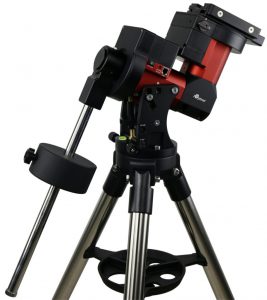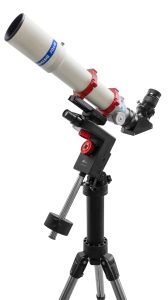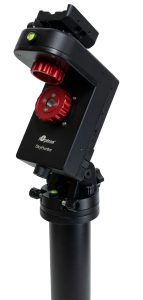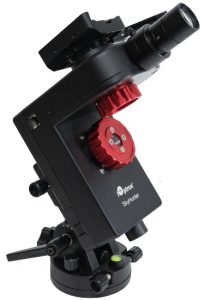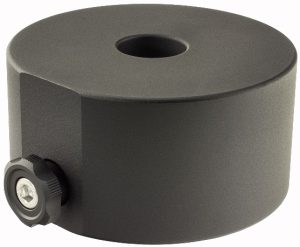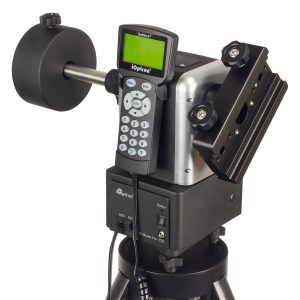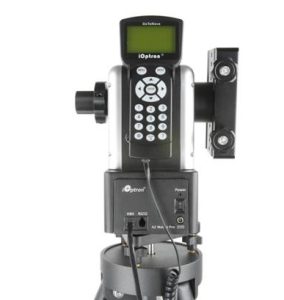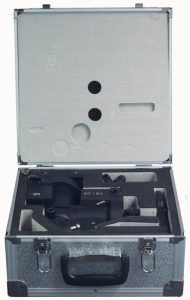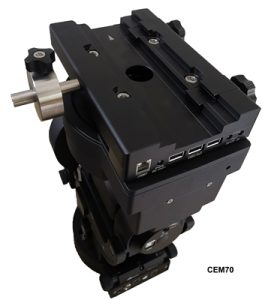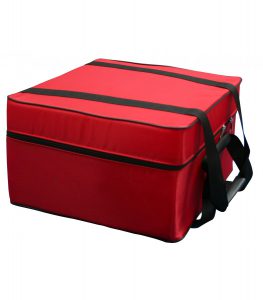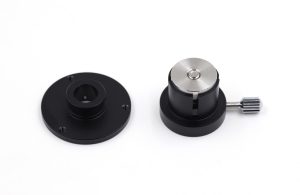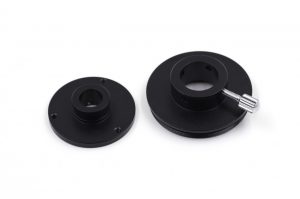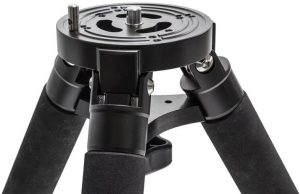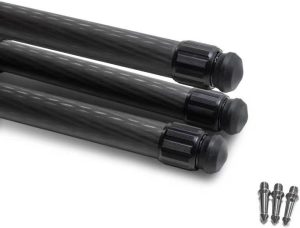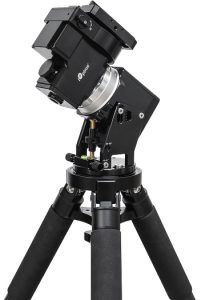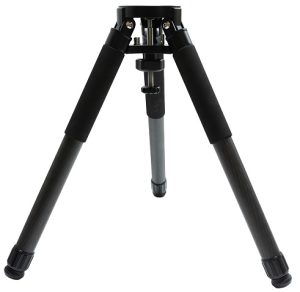Search Results for: iOptron
iOptron SHEQA2
Ioptron SHEQA3
iOptron SHEQA.
iOptron SkyHunter EQ/AZ goto montering
iOptron gewicht 9.5 7226
iOptron 9.5 kg gewicht voor CEM monteringen
iOptron_AZ_Mount_Pro_1
iOptron AZ_Mount_Pro_8903
ioptron-cem26-mount-with-ipolar-in-hard-case-literoc-175-inch-tripod
iOptron Z-axis kit 8439-2T 3
William Optics Extension bar for SkyGuider Pro
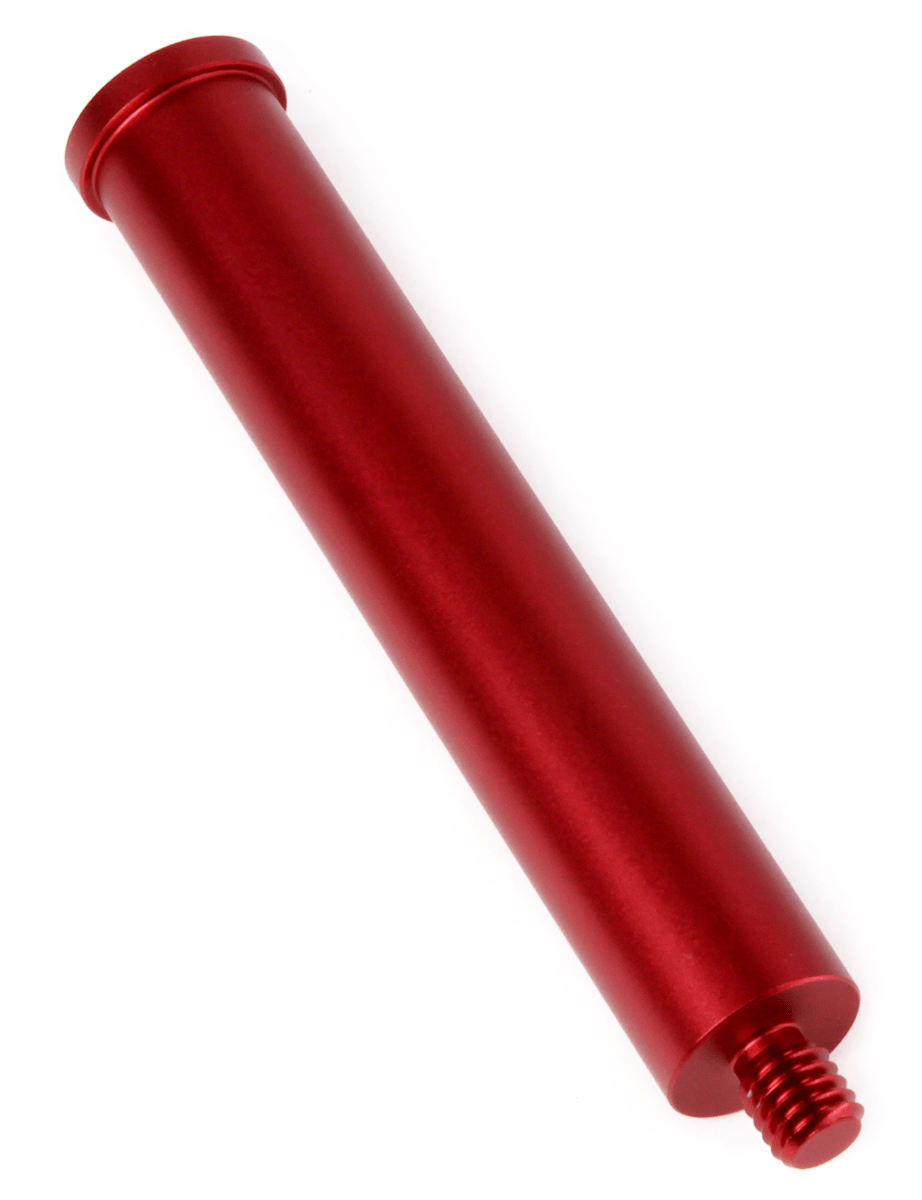
William Optics Extension bar for SkyGuider Pro
Extensie bar voor op de iOptron SkyGuider Pro montering. Hiermee verleng je de bar waar het tegengewicht op zit.
Specificaties van de William Optics Extension bar for SkyGuider Pro zijn:
- Lengte: 11.9 cm
- Gewicht: 105 gram
7100P-HC-2
iOptron CEM 25P goto montering 2 inch statief
30B0512-1050×1200
Geoptik PACK IN BAG IOPTRON 45
PrimaLucaLab Eagle cable 5.5 – 2.1 connector – 115cm for 3A port
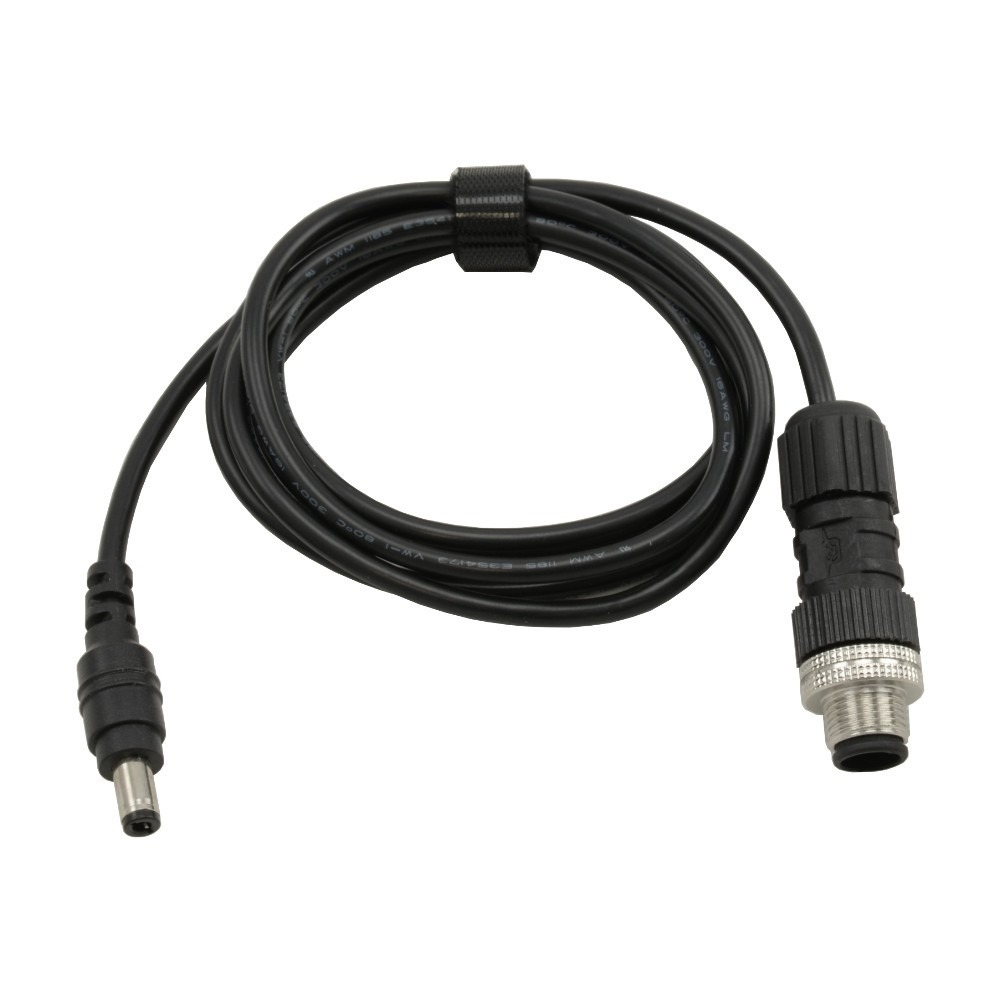
PrimaLucaLab Eagle cable 5.5 – 2.1 connector – 115cm for 3A port
This Eagle compatible power cable allows you to power devices supplied with 5.5 (outer diameter) – 2.1 (inner diameter), positive tip polarity. This cable connects to the 3A port of the EAGLE, with screw connector to prevent unwanted disconnection.
The cable is 115 cm long. By using this cable, you can power these devices such as SkyWatcher EQ6, HEQ5 and EQ5, Celestron AVX and CGEM iOptron, Avalon-Instruments and Losmandy mounts.
Specifications of the PrimaLucaLab Eagle cable 5.5 – 2.1 connector – 115cm for 3A port are:
- Length: 115 cm
- For Eagle 3 amp port
- Connector: 5.5 – 2.1
Omegon Balhoofd Pro OM10 voor camera statief
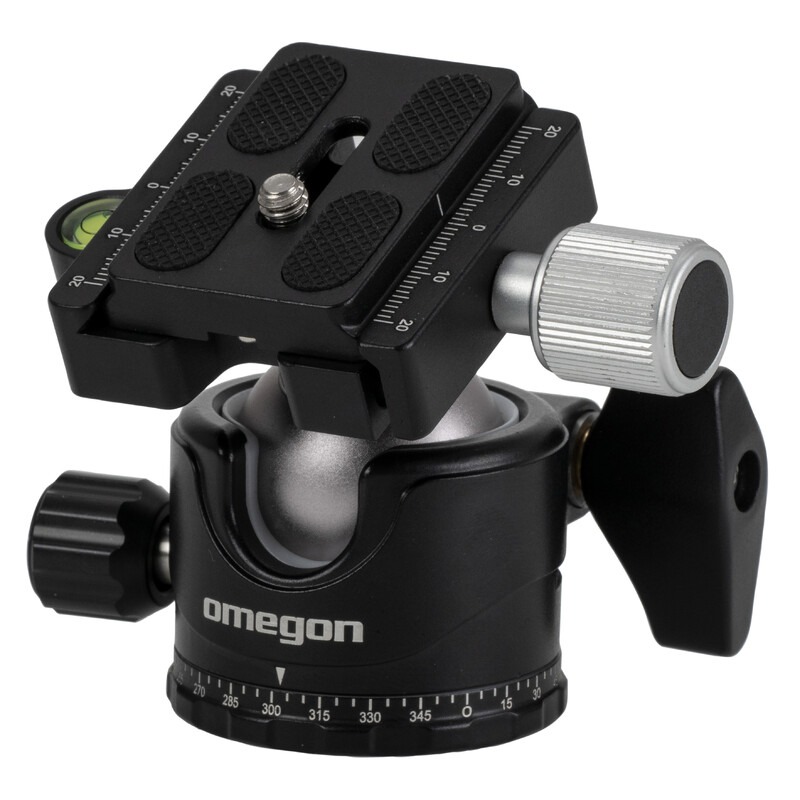
Omegon Balhoofd Pro OM10 voor camera statief
Draagvermogen van 10 kilogram voor camera’s met zware objectieven
Dit balhoofd is ideaal voor middelgrote en grote statieven. Overal waar zware camera’s en een hoge precisie van belang zijn, komt dit balhoofd als geroepen. Het laat zich soepel in elke gewenste richting bewegen, met waterpas, 360°-schaal en een praktische snelkoppelingsplaat: de OM10 heeft alles wat een balhoofd moet hebben – de stabiele basis voor geslaagde foto’s.
De voordelen op een rij:
- Rechte horizon, vlakke ondergrond? Met de waterpas lijnt u uw camera altijd perfect uit
- Snelkoppelingsplaat met valbeveiliging en een grote vlakke zwaluwstaartklem voor extra grip
- 360°-schaal voor geslaagde panoramafoto’s
- 3/8 inch-aansluiting: monteer de statiefkop gewoon op het statief door middel van de schroefdraad
- Gripvaste schroef die u ook met handschoenen gemakkelijk kunt bedienen
- Hoogwaardige afwerking: een combinatie van aluminium en roestvrij staal, zodat u vele jaren plezier beleeft aan uw balhoofd
Balhoofd voor alle richtingen
Het voordeel van een balhoofd is dat u hiermee de camera vrij in alle richtingen kunt bewegen. En indien nodig kan dit bovendien zeer snel. U spot een steenarend die zich hoog de lucht in boort? Deze op beeld vast te leggen is alles behalve eenvoudig. Maar met een balhoofd maakt u nu een echte kans! Geen wirwar aan hendels; u bepaalt intuïtief het doelwit van uw camera.
360°-panoramaschaal
Met dit balhoofd draait u uw optiek snel en eenvoudig 360°. Daarvoor beschikt de statiefkop over een lijnschaal met twee indelingen van 0 tot 180 graden, ideaal voor geslaagde panoramafoto’s.
De horizon is vanaf nu altijd vlak
Maak al uw foto’s vanuit de perfecte hoek, want met de waterpas lukken parallelle foto’s in elke gewenste richting.
Snelkoppelingsplaat met een groot klemoppervlak
Met de snelkoppelingsplaat monteert u binnen enkele seconden een camera of verrekijker op uw statief. De grote klemschroef aan de zijkant, die uw instrument met grote kracht fixeert, garandeert een veilige grip. Het voordeel: u kunt de plaat bovenop het balhoofd ongeveer een centimeter in beide richtingen verschuiven. Dat zorgt eveneens voor een valbeveiliging in het geval dat de klemming niet volledig aangedraaid zou zijn. Uw waardevolle optiek staat op het balhoofd dus altijd veilig gemonteerd.
Levering van het Omegon balhoofd omvat:
- Omegon Balhoofd Pro OM10
- Snelkoppelingsplaat
Plaats je bestelling online of kom langs in de winkel
Heb je gevonden wat je zoekt en wil je bijvoorbeeld de Omegon balhoofd Pro OM10 bestellen? Dan doe je dit heel eenvoudig online. Bekijk je deze producten liever in het echt voordat je ze koopt? Ook dat is bij ons mogelijk. Je bent van harte welkom in onze showroom in Amstelveen van maandag tot vrijdag tussen 10.00 en 17.00 uur. Op zaterdag is de showroom ook geopend, maar dan van 10.00 tot 16.30 uur. Voor meer informatie en advies kun je ook telefonisch contact met ons opnemen via 020-6412083. We helpen je graag.
Omegon OM8 balhoofd voor camera statief
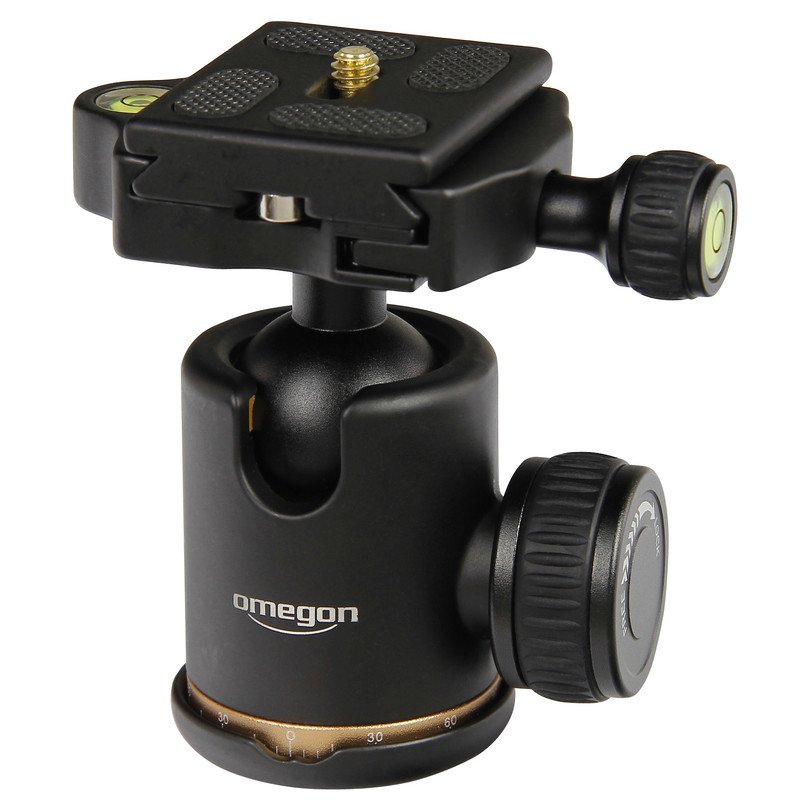
Omegon OM8 balhoofd voor camera statief
3 kg draagvermogen voor kleine en middelgrote camera’s
Op trips of op kleine statieven – de kleine OM8-kogelkop is perfect. Het heeft alles wat een balhoofd nodig heeft, maar bespaart toch veel gewicht. Ideaal voor de meeste spiegelreflex- en systeemcamera’s.
De voordelen in een notendop
- Balhoofd van aluminium, zwart geanodiseerd, 310 gram
- Twee waterpassen voor perfect uitgelijnde foto’s
- Wrijvingsschroef met hoge grip – hiermee kunt u de soepele loop van het balhoofd precies afstemmen op uw instrument en uw voorkeuren
- 3/8″ statiefschroefdraad, 1/4″ statiefschroef voor montage van camera of verrekijker
- Snel wisselplaat met faalveilige functie en platte prismaklemming voor een extra sterke grip
- Kogelkop – voor alle richtingen
Het voordeel van een balhoofd is dat je je camera zo vrij in alle richtingen kunt bewegen. Dus je kunt er heel snel mee zijn als het er toe doet. Stel dat je een steenarend hoog in de lucht ziet cirkelen – het vastleggen in het gezichtsveld is niet eenvoudig, maar een balhoofd geeft je een echte kans! In plaats van dat je meerdere hendels moet gebruiken, kun je je camera intuïtief verplaatsen naar waar hij moet zijn.
360 graden panoramaschaal
Een nauwkeurige 360° pan is eenvoudig met dit balhoofd. Er is een lijnschaal met twee verdelingen tussen 0 en 180 graden. Ideaal voor succesvolle panoramische opnamen. Al uw foto’s worden onder de perfecte hoek genomen. Met twee waterpassen zijn parallelle opnamen in elke richting mogelijk – horizontaal of verticaal.
Snel wisselplaat en vlakklemming
Met de snel wisselplaat monteer je binnen enkele seconden een camera of verrekijker op je statief. De klembout aan de zijkant, die uw instrument extreem stevig plat op het statief fixeert, zorgt voor een veilige grip. Het voordeel: u kunt de plaat ongeveer 2,5 cm in beide richtingen verplaatsen. Bovendien heeft het ook een veiligheidsfunctie voor het geval de klem niet volledig is vastgedraaid. Uw waardevolle optieken zijn altijd veilig gemonteerd op de OM8-kogelkop.
Levering van het Omegon OM8 balhoofd voor statief omvat:
- Omegon Balhoofd OM8
- Snelkoppelingsplaat
Speciale kenmerken:
- Tilt Lock: Ja
- Bediening met 1 hand: Ja
- Snelkoppeling: Ja
- Graden schaalverdeling: Ja
- Gewicht: 0.3 kg
PMcem25-s
QHYCCD PoleMaster iOptron CEM25 Adapter
PMcem60-s
QHYCCD PoleMaster iOptron CEM60 adapter
iOptron7103P-2T
iOptron CEM25P LiteRoc Tripod
Pegasus Astro cable 2.1 to 2.5 mm connector
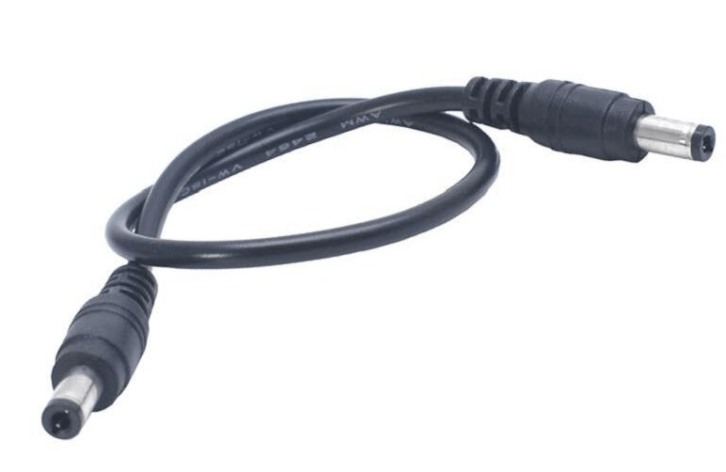
Pegasus Astro cable with 2 different connectors
With this Pegasus Astro cable 2.1 to 2.5 mm connector you can easily go from your Pegasus Astro Powerbox to, for example, a NUC. The connectors have a size of 5.5 x 2.1 and 5.5 x 2.5 mm. You can now easily connect products that have an input with 5.5 x 2.5, such as the iOptron CEM70 mount for example.

Specifications of the Pegasus Astro cable 2.1 to 2.5 mm connector:
- Male connector 5.5 x 2.1 mm
- Male connector 5.5 x 2.5 mm
- Length: 50 cm
- Maximum Amperage: 5 amps
Looking for other accessories from Pegasus Astro
If you are looking for other Pegasus Astro products that are not on our website, please contact us. Ganymedes regularly places an order with Pegasus Astro and so we can easily bring any order along.
8061-9
Ioptron carbon fibre statief
8061-10
Ioptron carbon fibre statief
8061-3
Ioptron carbon fibre statief
8061-2
Ioptron carbon fibre statief
William Optics Base mount Vixen stijl
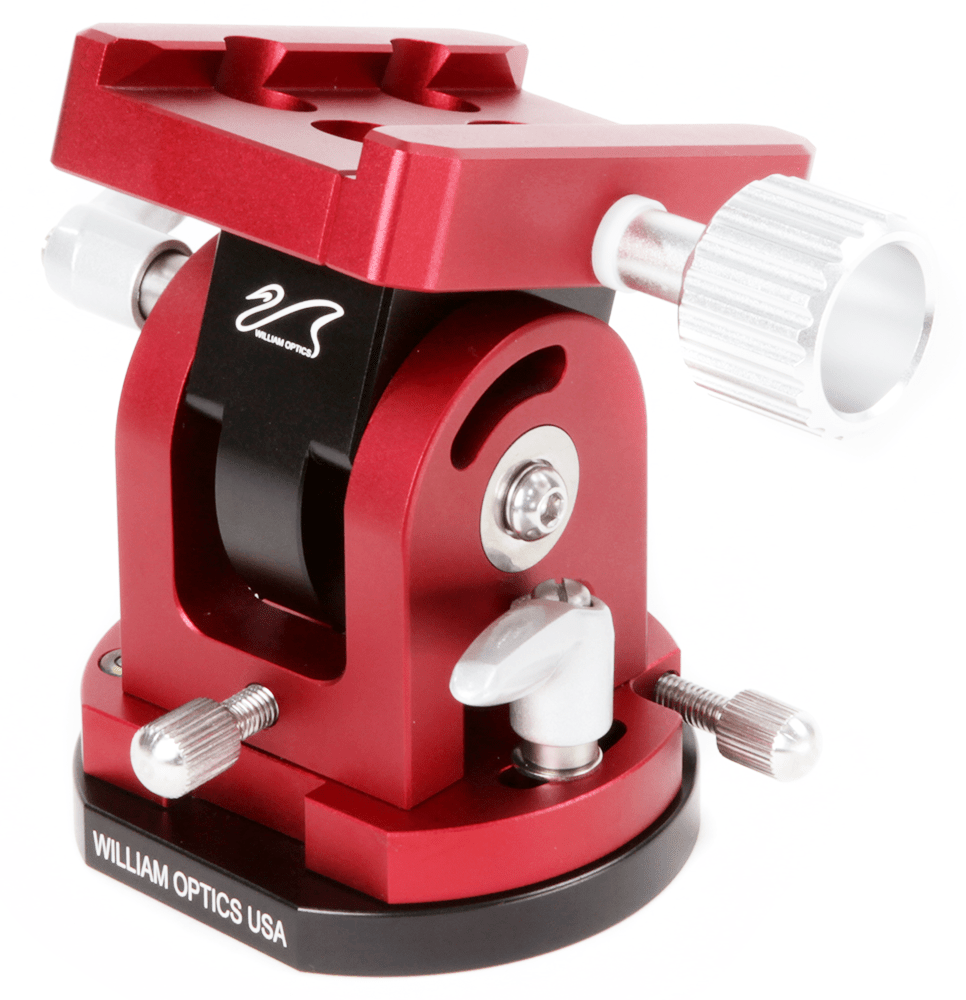
WO Vixen-stijl montering geschikt voor onder meer iOptron Skyguider Pro
De William Optics Base mount Vixen stijl is een goede upgrade voor je iOptron SkyGuider Pro of SkyWatcher Star Adventure. Je kan hiermee je foto montering makkelijk op de pool ster richten. De stabiliteit en functionaliteit doen de rest. De basis montering is in te stellen van 32 tot 59 graden ongeveer. Het gewicht bedraagt slecht 990 gram. 100% met CNC precisie gemaakt.
William Optics Base mount Vixen stijl geschikt hogere breedtegraad
William optics heeft 2 modellen gemaakt van deze montering. Eentje voor een lagere breedtegraad en eentje voor een hogere breedtegraad. Dit product is geschikt voor een breedtegraad van 32 ~ 59 graden.
Uitstekend geschikt dus voor onze regio.
Levering geschiedt zonder verlengstuk op tegengewicht as zoals op de foto! Deze “extension bar” is als een extra accessoire te bestellen.
William Optics producten
Producten van William Optics staan voor hoge kwaliteit in afwerking en gebruiksgemak. Je ziet, voelt en beleefd de kwaliteit als je het vasthoudt, naar kijkt en in gebruik neemt. De telescopen van William Optics staan al jaren bekend om hun betaalbare prijs en hoge kwaliteit en voorzien van allerlei slimmigheden. Zoals bijvoorbeeld het standaard handvat op de verschillende telescopen, deze is voorzien van een sleuf waar je een William Optics Uniguide scope in kan schuiven. Of neem de RedCat telescoop, een unieke telescoop die ook inzetbaar is als fotolens. Voor meer informatie over William Optics of over andere merken ben je van harte welkom in onze nieuwe showroom of neem contact met ons op 020-6412083.
Levering van de WO Base mount Vixen stijl omvat:
- Base mount, voor hogere breedtegraad (32 ~ 59)
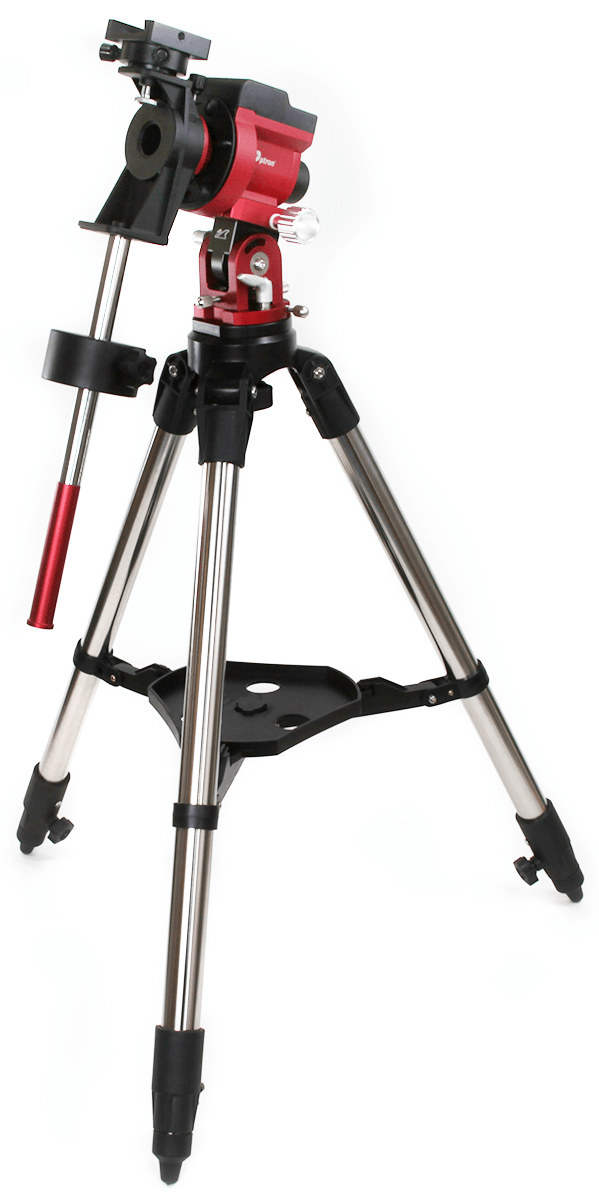
William Optics Dec Adapter SkyGuider Pro
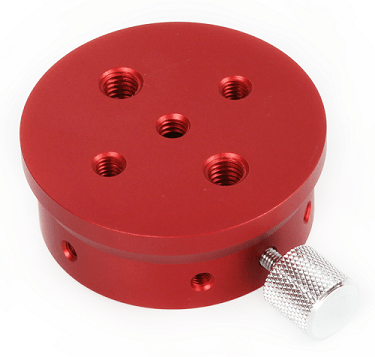
Verbeter je iOptron SkyGuider pro met deze dec adapter
De Dec adapter van William Optics is een vervanging van de standaard adapter op de SkyGuider Pro. Op de adapter kan je nog een Vixen klem bevestigen, ook leverbaar van William Optics. Deze Dec adapter is in zijn geheel een flinke verbetering voor de standaard klem. Voor bevestiging zie de foto’s hieronder.
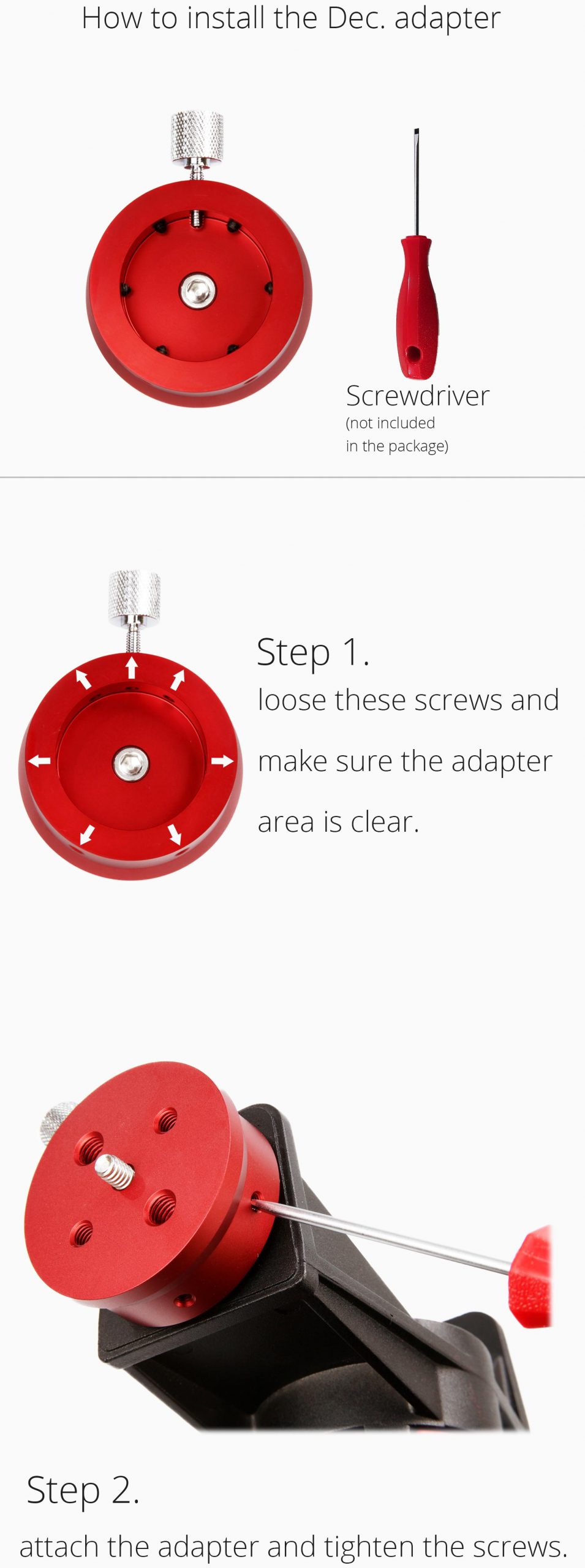
Levering van de William Optics Dec Adapter SkyGuider Pro omvat:
- SkyGuider pro declinatie adapter
Plaats je bestelling online of kom langs in de winkel
Heb je gevonden wat je zoekt en wil je bijvoorbeeld de dec adapter bestellen? Dan doe je dit heel eenvoudig online. Bekijk je deze producten liever in het echt voordat je ze koopt? Ook dat is bij ons mogelijk. Je bent van harte welkom in onze showroom in Amstelveen van maandag tot vrijdag tussen 10.00 en 17.00 uur. Op zaterdag is de showroom ook geopend, maar dan van 10.00 tot 16.30 uur. Voor meer informatie en advies kun je ook telefonisch contact met ons opnemen via 020-6412083. We helpen je graag.
ZWO TC40 tripod
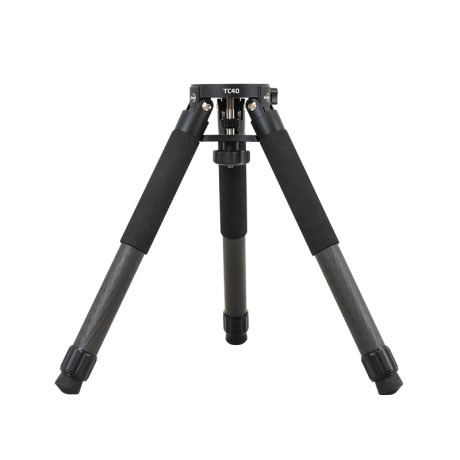
ZWO’s new tripod for the recently released ZWO AM5 mount, among others
ZWO recently introduced a new mount based on the latest harmonic drive technology. ZWO has also developed a matching tripod: the ZWO TC40 tripod (carbon fiber). Features of this tripod include the following highlights:
- Portable.
- Stable.
- Durable.
- …And more!
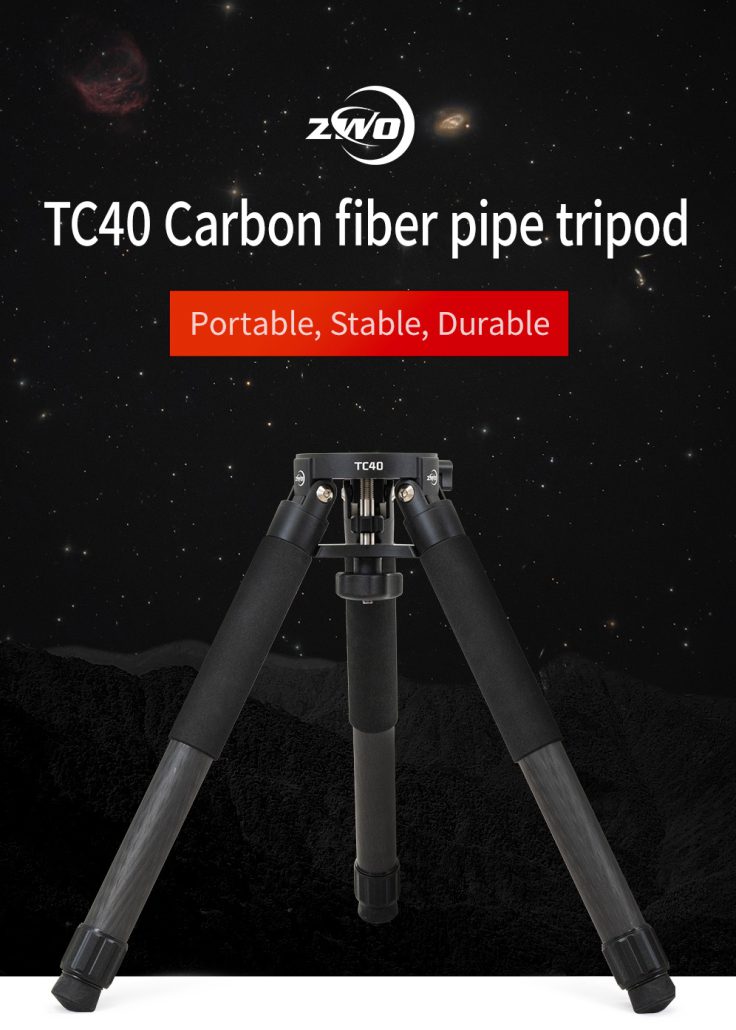
Some key specifications
- Weight: 2.3kg
- Load capacity: 50kg
- Folded length: 500mm
- Adjustable height: 470mm-1800mm
- Sections: 2
- Leg diameter: upper part 40mm / lower part 36mm
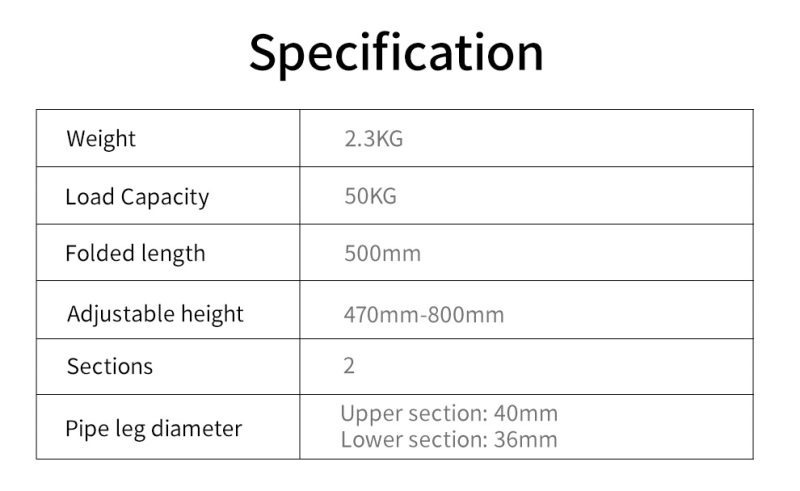
Lightweight design with large carrying weight
The ZWO carbon fiber tripod is excellently portable, made from tremendously strong construction and features high impact resistance.
- Tripod weight: 2.3kg
- Carrying weight: 50kg
As a result, this tripod is easy to carry. The TC40 tripod can be folded for easy transport in your carry-on luggage.
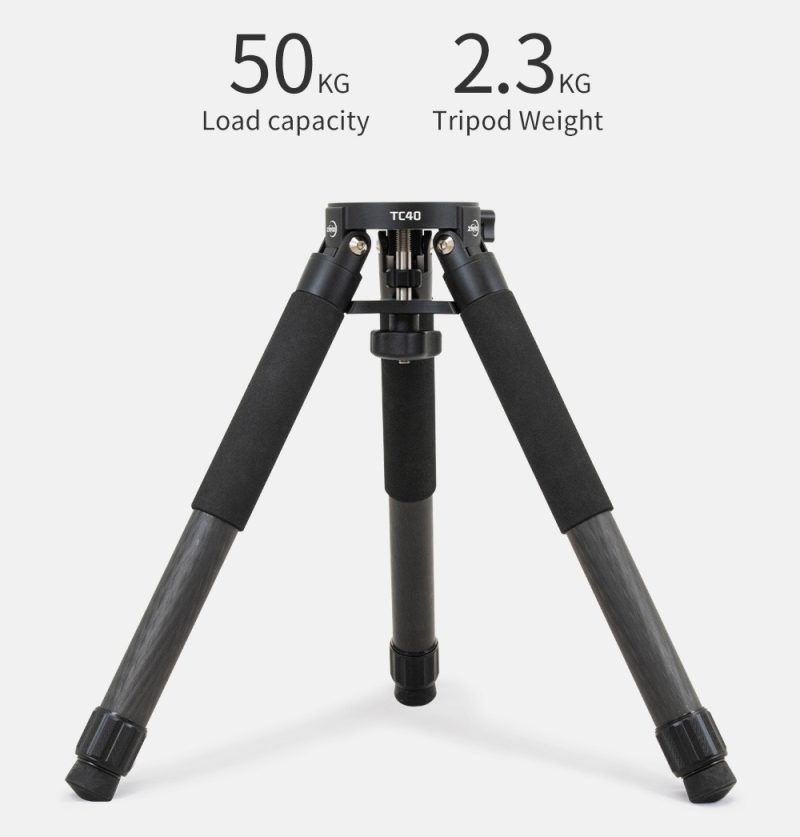
Adjustable height
The height is adjustable between 470mm and 800mm. Two-piece legs provide a stable and rigid platform for both telescopes and cameras, and of course any other accessories you want to connect to your setup.
Specifications tripod leg diameter:
- Upper part: 40mm
- Lower part: 36mm
This results in the configurable options below:
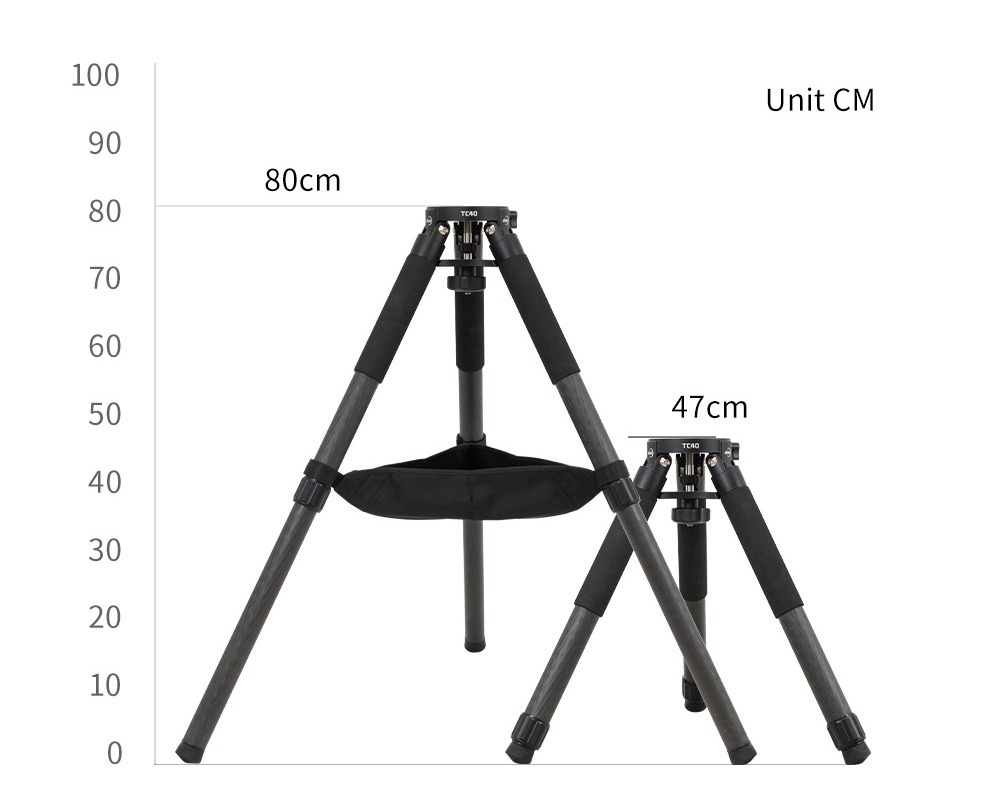
Stable performance
Tripod head plate: the adapter plate provides three mounting points to fit the AM5 head. The connection will be very stable and firm.
Mounting points. Safe lock
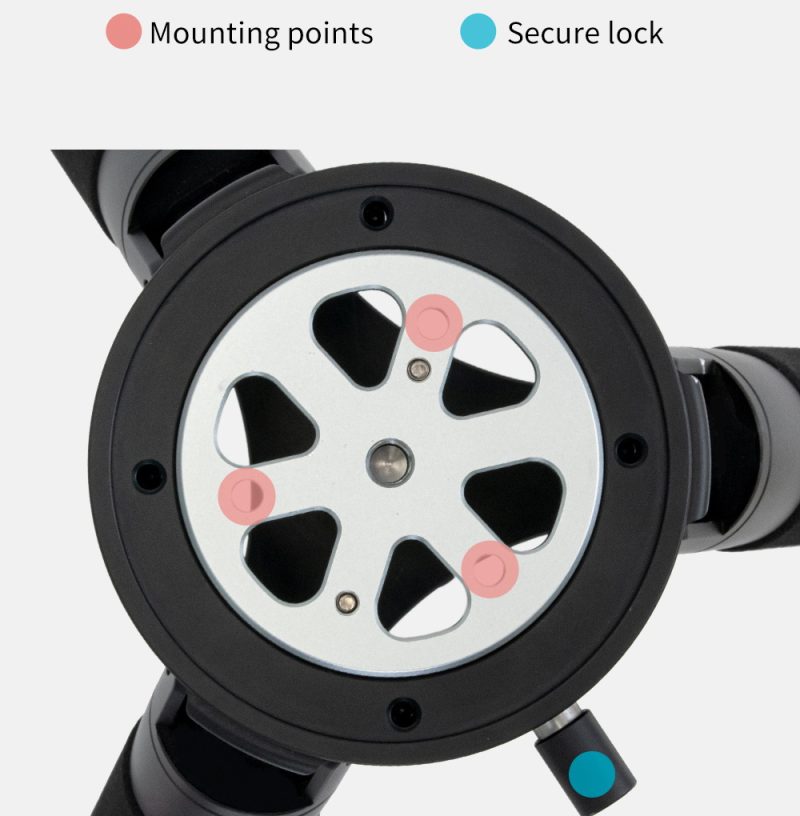
Central locking button
The center 3/8″ locking knob offers a wide range of compatibility:
- Keep it standard: for use with the AM5 head.
- Hold upside down: for quickly attaching other holders with a 3/8″ threaded hole to the tripod.
- Secure locking: effectively reinforces the connection of the mounting head and tripod
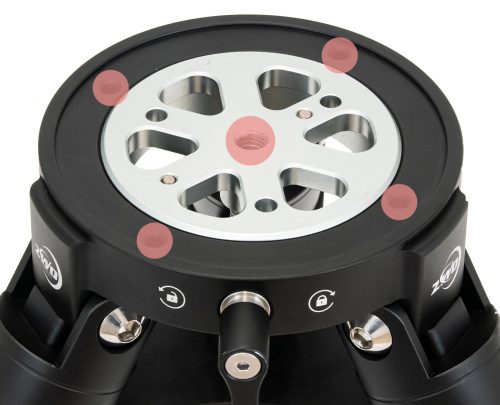
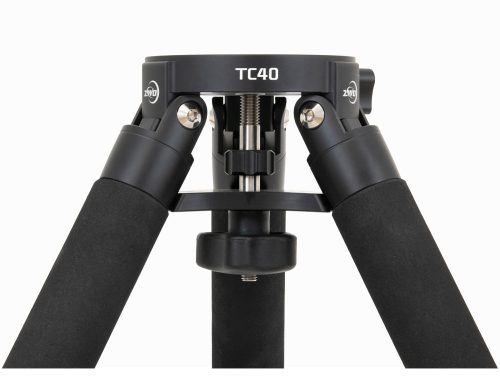
Spreading plate of the ZWO TC40 tripod
The spreader plate increases stability. When you tighten the knob, the spreader plate is pushed up against the legs. As a result, you spread the legs well and lock them in place.
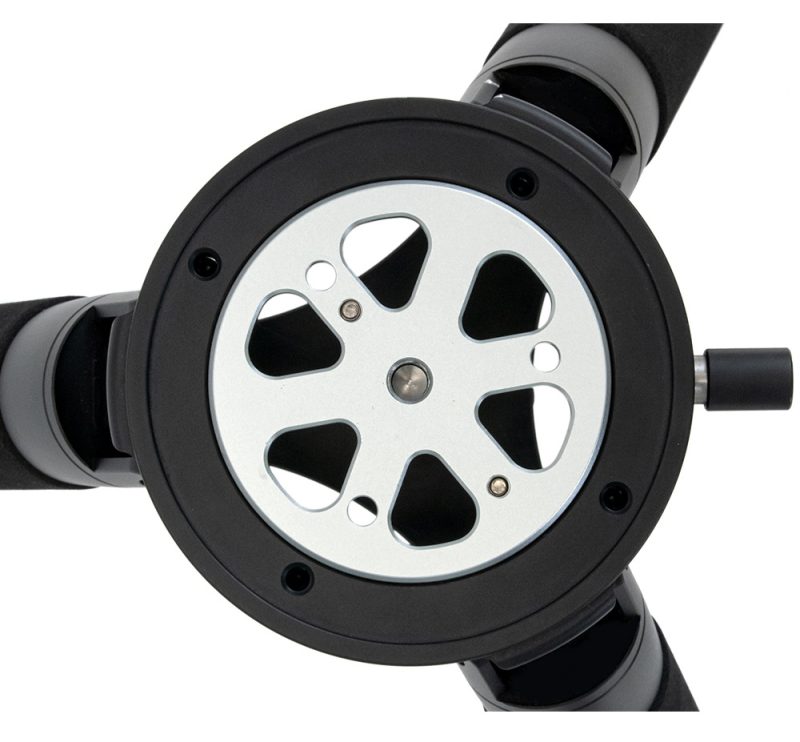
Ballast bag of the ZWO TC40 tripod
Provides additional stability by filling the ballast bag with a suitable weight such as rocks or your telescope battery pack.
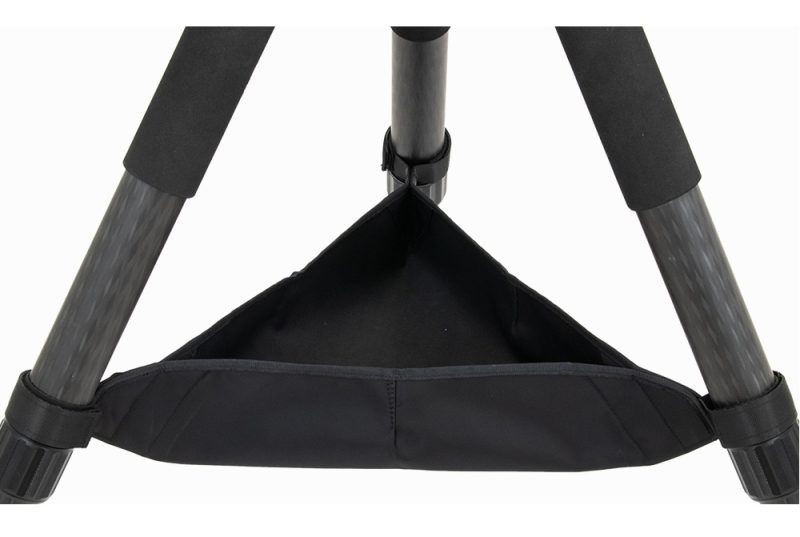
Delivery of the ZWO TC40 tripod includes:
- Tripod
- Ballast bag for the tripod
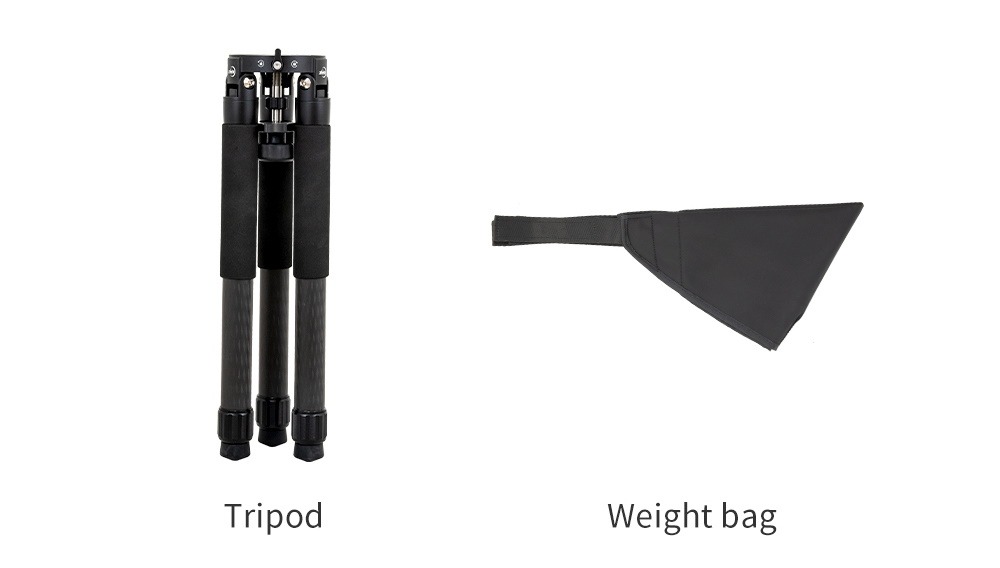
Compatibility with other mounts
- iOptron GEM45
- iOptron GEM40
- Rainbow Astro RST-135E
- Sky-Watcher AZ-GTi
- Compatibility capabilities many other mounts(contact us for a compatibility check)
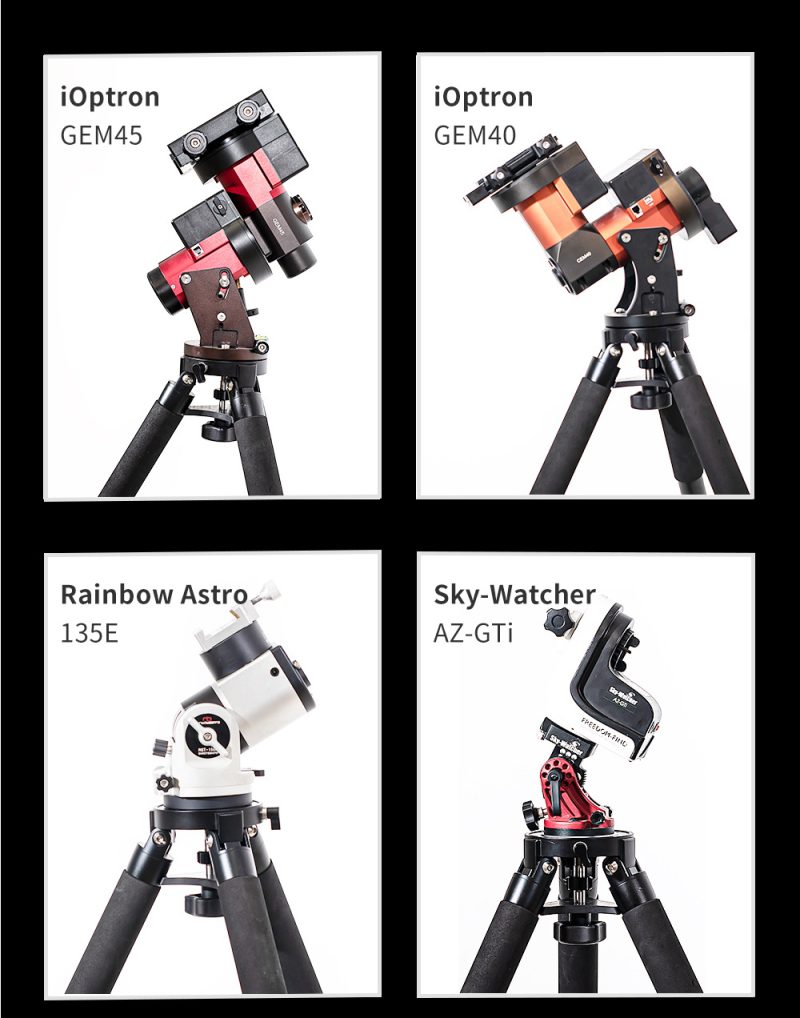
Schematic view
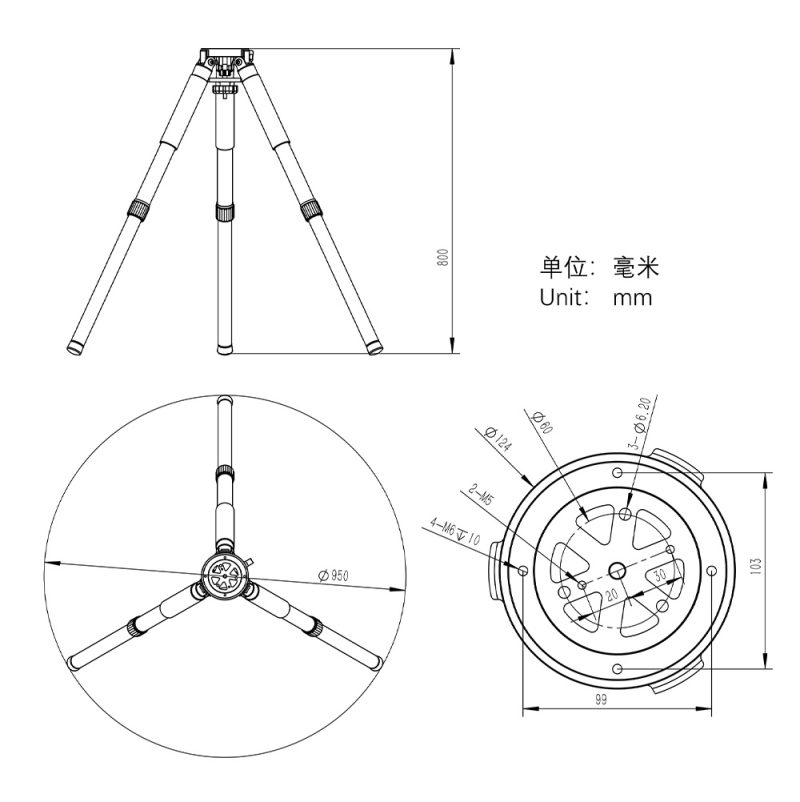
Example full assembly
See below an example of the complete assembly of the ZWO AM5 Harmonic equatorial mount mounted on the ZWO TC40 tripod with a Celestron telescope:
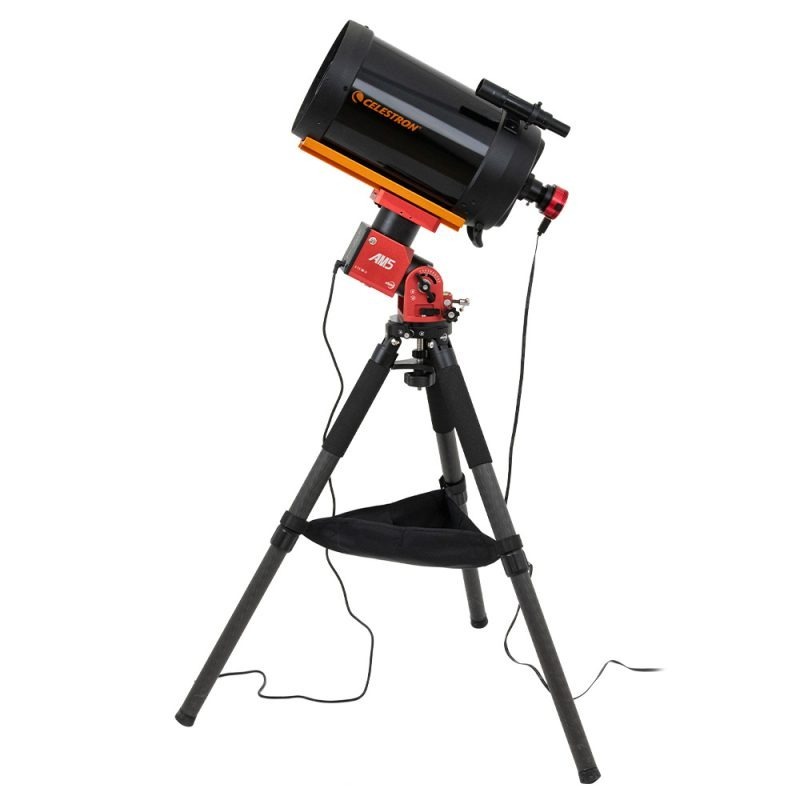
Place your order online or visit the showroom in Amstelveen
Take super-sharp astronomical photos with a camera from ZWO in a stable manner with the ZWO AM5 Harmonic equatorial mount and this tripod. Easily order this tripod online at Ganymedes or stop by our showroom in Amstelveen. You are welcome here on weekdays between 10 a.m. and 5 p.m. or on Saturdays between 10 a.m. and 4.30 p.m. Do you have questions about our products? We are always ready with good service. Call 020-6412083 and we will be happy to help you.
Omegon hoekkijker voor pool zoeker, 90°
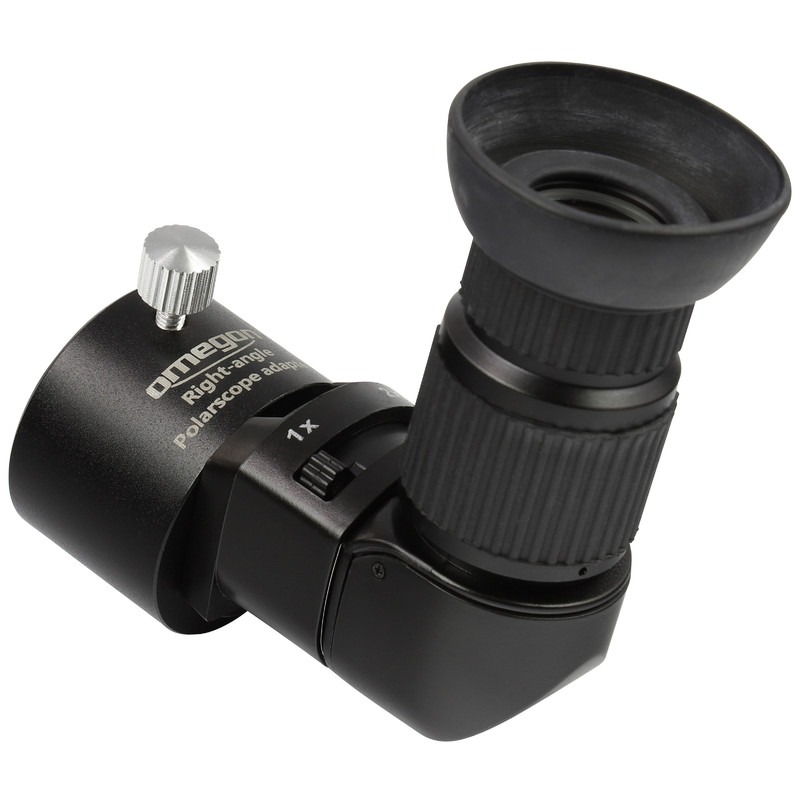
Je kan op de grond hurken, maar er bestaat een comfortabelere manier om de poolster te vinden.
Omegon hoekkijker voor pool zoeker, 90° zorgt ervoor dat knielen op de grond en in een gespannen houding door de pool zoeker kijken niet meer nodig is. Je montering op het noorden richten is een onaangename klus, ook voor jongere mensen. En dit alleen maar het geval omdat de pool zoeker recht en in een steile hoek naar beneden wijst. De Omegon 90°-hoekzoeker maakt dit werk nu kinderspel en uiterst aangenaam. En dit alles zonder rugpijn.
De voordelen op een rij:
- De pool zoeker is gemakkelijker in te stellen: kijk door uw pool zoeker in een hoek van 90°.
- Nooit meer op de grond knielen bij het verstellen van de pool.
- De beeldoriëntatie blijft hetzelfde wanneer u door het beeld kijkt.
- Focus: de scherpte is instelbaar.
- Zoomfactor 1x en 2x: voor overzicht en nauwkeurige details.
- Plaats de metalen 90°-hoekzoeker met Amici-prisma en coating op de optische oppervlakken over de pool zoeker en fixeer hem.
Je hebt het bij observatie vast wel eens meegemaakt: wanneer je in een comfortabele positie observeert, zie je de objecten ook beter en intensiever. Dit is te vergelijken met jouw pool zoeker: je hebt meer tijd om alles in te stellen. Profiteer van een nauwkeurigere en grondige positionering van uw montering.
360 graden draaibaar
Zelfs wanner je een stukje zijdelings naar rechts of links van de montering door de pool zoeker kijkt: de hoekzoeker kan naar believen worden gedraaid.
Focus: Scherpe markering te allen tijde
Te allen tijde een scherp zicht op de Poolster en het dradenkruis: dit is een voorwaarde die de hoekzoeker biedt. Je kan de geïntegreerde optiek net zo eenvoudig aan je gezichtsscherpte aanpassen als een focuser. Dit is ook een groot pluspunt voor brildragers.
Rubberen oog schelp voor een ongestoord zicht
De trechtervormige oogschelp biedt je een contrastrijk beeld zonder strooilicht van buitenaf. Praktisch: hij kan ook gemakkelijk worden omgeklapt.
Zoomniveaus: 1x en 2x
In het normale beeld biedt de hoekzoeker je een royaal overzicht. Maar soms zijn de centrale cirkels van een pool zoeker het belangrijkst. Verhoog in dat geval de vergroting tot 2x en je zult dat wat belangrijk is zien, duidelijk vergroot.
Past deze hoekzoeker op mijn montering?
Met een binnendiameter van 30 mm past de Omegon hoekzoeker op de pool zoeker van de meest gangbare monteringen. Dit werkt eenvoudig en zonder schroefdraad: gewoon aanzetten, de kartelschroeven vastdraaien, klaar.
Een selectie van monteringen waar de Omegon hoekkijker voor pool zoeker, 90° op past:
- Skywatcher: EQ5, AZ-EQ5, HEQ5, EQ6, AZ-EQ6, Adventurer, Adventurer mini
- Orion: Atlas Pro, Atlas EQ-G
- Celestron: AVX, CGEM
- Lacerta: Polarie Poolzoeker
- Niet geschikt voor iOptron poolzoekers!
Richt je montering gemakkelijker en comfortabeler op het noorden met de Omegon hoekzoeker dan ooit tevoren.
ADM VDUP3 Vixen zwaluwstaart verbinding
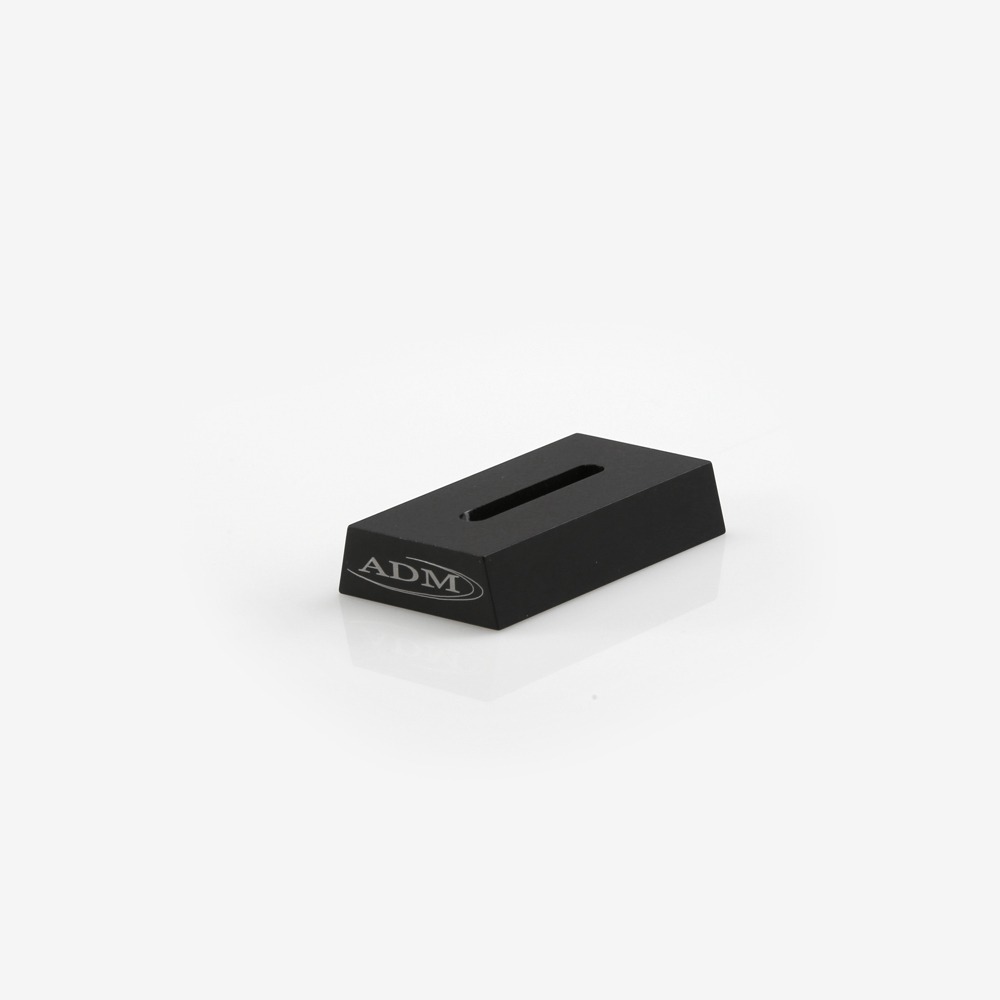
ADM VDUP3 Vixen Zwaluwstaart
VUDP zwaluwstaarten van ADM accessoires zijn universele zwaluwstaarten in Vixen style afmeting. Deze zwaluwstaarten passen op diverse verschillende merken monteringen, zoals die van Celestron, Meade, Orion, iOptron, SkyWatcher, TeleVue, Vixen.
Deze zwaluwstaarten worden in 5 verschillende lengtes geleverd, de lengtes zijn dus variërend van 7.5 cm tot 35 cm. In alle maten zijn ze voorzien van een sleuf, in de drie langste maten zitten er ook gaten in. Deze gaten zitten op een hart afstand van 2.5 cm van elkaar in de breedte.
Prijzen veranderen in de winkelwagen. We zijn bezig om te zorgen dat de prijs meteen verandert bij het selecteren van de lengte van de VDUP.
Kenmerken van de ADM VDUP3 Vixen Zwaluwstaart zijn:
- Breedte van 4.3 cm
- Hoogte van 1.56 cm
- Lengte van 7.5 cm
Buying a telescope? This is where you have to watch out | Ganymedes Amstelveen
Buying a telescope? But what exactly should you pay attention to? We’ve compiled everything we know about telescopes for you and are happy to share it with you so you can find and purchase the best telescope for your needs and/or situation.
The market for telescopes is booming! More and more people are getting hooked on stargazing. In the Netherlands, thousands of people practice the hobby of astronomy. Often they are united in amateur associations. Public observatories can be found everywhere in the Netherlands. Most people who have visited a viewing night once become infected with the virus and want to buy a telescope themselves.
The price of telescopes ranges pretty much from 200 euros to 17,000 euros. So there is something for everyone!
As with any investment, you undoubtedly want to weigh the pros and cons. So in this blog we are definitely going to talk about focal lengths, apertures, diameters and eyepieces, but we will also make sure you start asking the right questions of yourself.
Grab a nice cup of coffee and brace yourself to learn all about telescopes. Do you have a little less time? Then jump directly to the topic you want to learn more about via the anchors below!
- How does a telescope actually work?
- The history of telescopes
- What types of telescopes are there?
- Terms you need to know
- We know, it’s painful, but adjust your expectations
- What do you want to go see?
- What place do you want to look at?
- Indispensable: a good tripod
- How to use a telescope
- How far can you see with an average quality telescope?
- What exactly is astrophotography and which telescope is suitable for it?
- Is a spotting scope also a telescope?
- Fun to read!
- Purchasing a telescope
How does a telescope actually work?
A telescope is an instrument that magnifies objects and/or can gather much more light than our own eyes. Whereas on Earth we use binoculars to magnify objects, we use a telescope for observations in the universe, that is, outside the Earth’s atmosphere. The first telescope even comes from Dutch soil. It was Hans Lippershey who placed two ground lenses in a copper tube, making all the objects you saw through the copper tube seem closer.
But how exactly does it work? If objects are far away then they are smaller and also darker to the point that they reflect so little light that they cannot reach our eyes.
Thus, to see objects from afar we must:
- Having as much light as possible;
- Magnifying the apparent object
One way to do this is to use lenses. The light rays reflecting off an object reach the object lens, but as a result they also distort and bend toward each other until they reach the focal point. The only problem now is that the image is perceived upside down, oops! Now the second lens comes in handy, namely the one closest to the eye. This ensures that the light rays are straightened, so to speak, before reaching the eye. Incidentally, it actually makes little difference that objects are inverted for deepsky objects and/or planets.
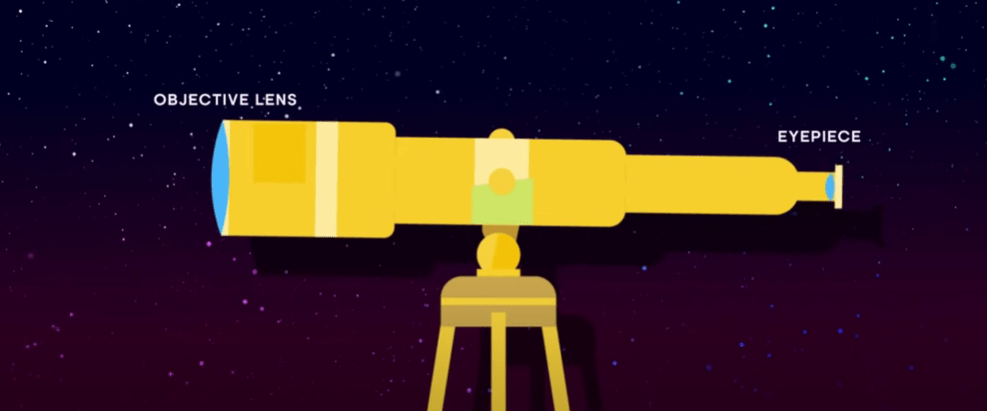
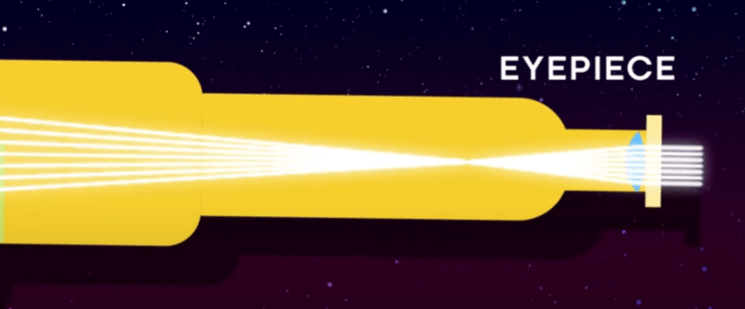
The other factor that matters is the amount of light. The amount of light that can pass through depends on the size of the objective lens. Of course, the size of a lens has its limitations. There are lenses more than a meter in diameter. A good example is the James Webb Space Telescope with a diameter of about 6.5 meters.
However, there is also a downside. So-called refractor telescopes (which thus work with light computation, or refraction) suffer from “lost light. The light that should pass through the lens is actually reflected. So not ideal.
The solution to this is the invention of the reflector telescope. This telescope does not work with Convex (convex) lenses like a refractor telescope, but with concave (concave) mirrors.
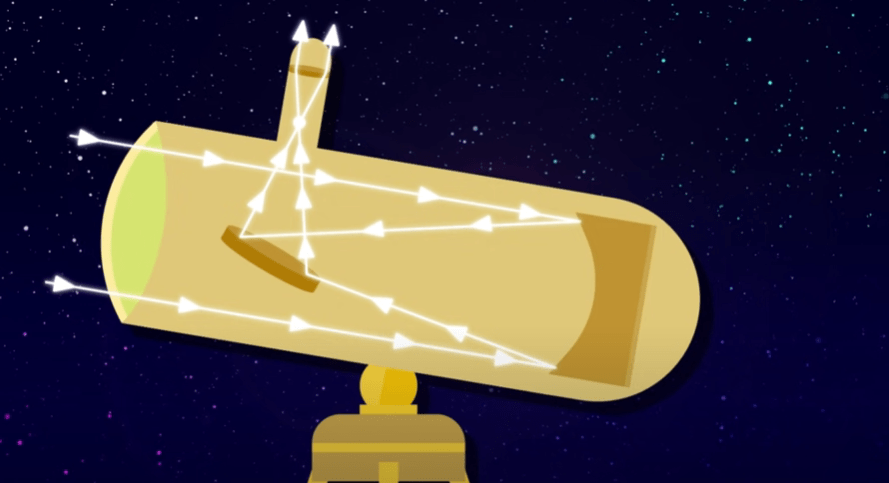
You still need a large mirror but the advantage is that it is easier to make large concave mirrors than large Convex lenses.
Consequently, the largest reflector telescope has a diameter of 10.4 meters!!! In fact, work is currently underway on a telescope as large as 30 meters in diameter and even larger!!!! Wow.
Every invention is made to get around a problem and make life a lot easier. Does this solve all our problems then? Not quite.
Regardless of the type of telescope you use, there exists the phenomenon of atmospheric distortion. If you look at a star with the naked eye, it appears to twinkle. So not very pleasant. That is why many telescopes are placed at height because the air is much thinner there and the effect is less pronounced.
And even better! You’ve probably heard of the Hubble Space Telescope! That was launched into space, allowing it to capture light rays from stars and planets (virtually) unimpeded. Recently, the James Webb Space Telescope was launched as a successor and/or complement to the Hubble Space Telescope.
And how accurate is this telescope, for example, you may be asking yourself! Well pretty accurate. Think of a firefly in Tokyo that you can observe in New York.
However, there are ways to magnify objects other than optically (the same way our eyes work, i.e., with light).
For example, the Spitzer telescope which works with infrared cameras that detect heat sources in space. The Kepler telescope is an unmanned spacecraft developed by Nasa to detect planets near other stars that may be habitable like Earth. The Kepler spacecraft uses a schmidt camera to study 100,000 stars at once.
Enough theory about telescopes! Let’s take a closer look at telescopes that may be right for you. We’ll walk you through the technical details so you can make an informed decision if you want to buy a telescope.
The history of telescopes
The Dutch are true inventors. The invention of the telescope demonstrates this. It is suspected that it was Hans Lipperhey who was the first to invent the telescope. Lipperhey, from Middelburg, was seemingly in a battle with two other men, namely, Sacharias Jansen and Jacob Adriaanszoon Metius. Lipperhey, however, was the first to file a successful patent application.
Yet there are also stories that Jansen was the first to come up with the idea of a telescope. Indeed, Jansen and Lipperhey were both spectacle grinders and were practically neighbors of each other. Rumor has it that Lipperhey went with Jansen’s invention when the latter traveled to Germany to promote his invention. We will never know exactly.
The Italian inventor Galileo Galilei was the first to come up with an improved version of the telescope, which made it possible to study celestial bodies. What he saw and could observe was at odds with scientific studies of the time. For the first time, dark spots on the sun could be observed, a myriad of stars, and he could see craters and mountains on the moon. His invention and studies are considered the beginning of modern astronomy.
The invention of the telescope is an important moment in human history. Today, the invention of the telescope still has many applications. It is used for maritime, military, scientific and astronomical applications. Prince Maurice of Orange immediately put pressure on his archenemy Ambrogia Spinola with the invention of the telescope. In turn, he responded that from now on he would never be safe because from now on he could be seen from afar.
An important feature of a good invention is that it keeps improving over time. So it was with the invention of the telescope.
What types of telescopes are there?
Lipperhey’s original invention is known as the “Dutch viewer”. However, the Dutch viewer had a limited viewing angle. Johannes Kepler developed a variant in which the viewing angle was much larger. Instead of a concave lens, he used a convex lens.
Another important development is the use of mirrors instead of lenses. Lenses also become heavier and more expensive the larger they are. In fact, lenses must be sharpened on both sides. Another phenomenon is chromatic aberration. This is caused by a property that glass has called “dispersion”. Color shifting is a name that might be a little clearer. In fact, light of different wavelengths is not refracted to the same extent at the surface of lenses.
Mirrors do not have these objections, which is why you also see that all the great telescopes in the world use mirrors.
Today, there are three types of telescopes, namely:
- Refractors: work primarily with lenses
- Mirror or reflectors: working with mirrors
- Catadioptric systems: working with mirrors and lenses
Terms you need to know
Aperture/diameter of the lens
This is an important feature you want to look for when buying a telescope. The diameter determines how much light is captured, the maximum resolution and thus the maximum useful magnification (see below). Available diameters can be found from 50mm to 356mm.
Focal length
The focal length is the distance light must travel to converge into a single point (the focal point). The focal length is an important number for telescopes. Partly because of the focal point, the magnification of a telescope is determined. In practice, you will find focal lengths from 250mm to 3910mm.
Many times on a telescope you will find the following D=102 mm F=1000 mm depending of course on the aperture and focal length.
Aperture / focal ratio
You find this number by dividing the focal length by the diameter (aperture). Practical ratios are 2 to 15. This number (f) indicates the speed of the device.
Minimum sensible magnification (x)
The size of a human pupil varies between 2 and 7mm. This maximum is used in calculating the minimum sensible magnification. You do this by dividing the diameter/aperture by 7 (maximum pupil size). It ranges from 1 to 50.
Maximum sensible magnification (x)
This is the magnification limit. It is approximately 2.34 times the aperture/diameter. The maximum is about 840 for available telescopes with an aperture of 356mm. Keep in mind the limits of our seeing, often magnification of more than 300 is not useful because the atmosphere through which we are looking is cloudy.
Maximum resolution
It can be calculated by dividing arcsec by the number of pixels. An arcsec is a number corresponding to 1/60. Practically, this is expressed as a grade 1 through 3. Resolution is important in relation to distinctiveness. High distinctiveness can distinguish 2 stars that are close to each other while with low distinctiveness it is perceived as 1 star.
Boundary magnitude
This is a somewhat theoretical figure. If you assume that a star with magnitude 6 is still clearly visible to the naked eye, then you can calculate the limiting magnitude as follows: 6+5x log (d). It is expressed in centimeters. The limiting magnitude for our telescopes is a maximum of 15.
Coatings
A coating increases light transmission. A coating is applied to the front correction plate and can provide up to 15% more light transmission. We know the following coatings: Starbright XLT, Fully-coated, STN-coated and Fully-multi-coated.
Telescope type
The first telescopes invented in the Netherlands were refractor telescopes. These telescopes work with refraction of light. Another word for refraction of light is refraction. Hence, these telescopes are called refractor telescopes. Refractor telescopes are still very popular for the consumer market.
Reflector telescopes use mostly convex mirrors. The major advantage over lenses is that mirrors do not suffer from color shifting due to the non-uniform refraction of light. In addition, as lenses become larger, they therefore also become much heavier and more expensive.
Then we also have Schmidt-Cassegrain telescopes. A beautiful name but what exactly is it? These are called Catadioptric telescopes. These use both lenses and mirrors. Light collection here is done by a mirror but a lens is also placed in the front of the viewer to eliminate image errors.
Then we have the Maksutov telescopes. These are telescopes with both mirrors and lenses.
It combines a mirror with a weakly negative meniscus lens. A meniscus lens is a lens with a convex and a concave side (i.e., both a convex and concave lens).
Maksutov you often see in Cassegrain variants hence the name Maksutov-Cassegrain telescopes.
In conclusion. There are particularly many telescope variants. Throughout the telescope’s rich history, designers have tried to correct errors and adverse effects. Today for consumer telescopes, telescope manufacturers naturally look at the manufacturing process and related costs.
Type of optics
We have already talked about mirrors and lenses. Looking further into lenses, a number of lens systems can be distinguished. For example, achromatic. Here the fire distance is equal at at least two wavelengths. The systems are designed to counteract adverse effects such as chromatic and spherical aberration.
In telescopes, you see 2-fold or even 3-fold variants (doublet / triplet).
Eyepiece
The eyepiece helps determine not only the magnification, but also the quality of the image. It goes somewhat in concert with optics of the telescope. To explain it easily, I will give the example of a stereo system. You can have a very good amplifier, but if the speakers are nothing you won’t get out of it what’s in it. And vice versa, the same is true. Are the speakers outstanding, but the clock radio is the amplifier, it will never be much. In this example, the speakers are the eyepieces. However, buying better eyepieces always gives an improvement in your image. And because the standard eyepiece size these days is 31.7 mm (1.25″), which is the diameter of the sleeve of the eyepiece that goes into the diagonal, you can always use the eyepiece again on another telescope. They used to use 24.5 mm (0.96″) eyepieces and now the 50.8 mm (2″ ) are on the rise. Standard with most telescope sets is 31.7 mm eyepieces. These are standard eyepieces, so in most cases there are still gains to be made here. It is also desirable to have multiple eyepieces so that you can easily search at the lowest magnification by having a larger field of view. If you have found the object then you can use another eyepiece for stronger magnification.
Field of view
The field of view of a telescope is partly determined by the focal point of a telescope, the longer the focal point the narrower/smaller the field of view is. In binoculars, for example, it often says 123 m/1000 m. This means that at 1000 meters away you have a field of view 123 meters wide. For binoculars, this is expressed in degrees. In stargazing it is less so, but because we are looking over a longer distance we can have the moon fully in view at reasonable magnification. Here it will be about 1 degree.
Diagonal
The diagonal is most commonly used with a lens system and Schmidt-Cassegrain system. With these telescopes, you look at the back of the telescope and it is desirable to be able to look into it from above. The diagonal comes in 45 degrees and 90 degrees. With a Newton system, you always look from the side of the telescope and do not need a diagonal. A telescope set usually includes a 90-degree diagonal. This sets the image straight, only left and right are swapped. In some telescope sets, this has also been adjusted. However, this is done with a prism and it often produces some loss in your image.
Mount
With mounts, you see roughly 2 forms, azimuthal and equatorial. Azimutal mounts you can move horizontally and vertically. Equatorial designs have the advantage that it always rotates with the pole star, requiring only 1 movement to track an object (e.g., a star). For performing astrophotography, an equatorial is generally the best choice.
Focuser type
These are the systems that are used. A well-known and widely used system is rack and pinion where a gear moves in a linear gear. The Crayford focuser is a more advanced system which works with a spring-loaded shaft that holds the focus tube opposite bearings and controls its movement.
Focuser size
Found in varieties from 1.25 inches to 3.5 inches. You’ll find the larger ones on the more expensive variants.
Tube material
The material of which the (sleeve of the) telescope is made. Each material has different characteristics in terms of hardness and robustness. The casing is made of such materials as aluminum, steel, plastic and carbon.
Seeing
Seeing is a concept that as you get further into the field, and talk to other amateurs, is something they always complain about. The seeing, or to throw in a fancy term astronomical vision, is term used in astronomy for the influence (blur, “twinkling”) of atmospheric disturbances (turbulence) on vision through telescopes. Visibility is one of the biggest problems in astronomical observations from Earth.
We tried to talk about the principles of stargazing in our own terms, as we at Ganymedes educate someone about a telescope. There are many other aspects to consider. In another blog, we will discuss in detail the topic of astrophotography.
Actually, it is wise to purchase the first telescope from a company or store where you can see and “feel” the telescope, and where you are actually explained how it works. Get informed and realize what kind of instrument you are bringing into the house. Most telescopes are on a tripod, and this is larger in reality than you can see in a photograph anyway. Also, most telescopes are easy to take apart and store, often in 3 main parts: tripod, mount and telescope.
There are a legion of models available on the market, of any brand at various toy stores or online bookstores. However, there is much, if not a lot of “junk” among them. Don’t be tempted by buying a toy telescope for little money. In that case, buy binoculars so they can at least explore the sky. With a toy telescope you ruin interest more than you generate it. You can see in our store what is cheap, we recommend this, but you can also see what you are buying something with for many fun evenings of viewing pleasure.
I hope that from this text you have become a little wiser in the matter of stargazing, and that you dare to take the step to explore the untold vast night sky. We, Jeroen, Peter and Paul, are here to help you get started. It takes a lot of patience and perseverance, but in return you get something special.
We know, it’s painful, but adjust your expectations
You’ve probably already fantasized what it would be like to see the wonderful world of the universe in detail. Perhaps also made a little crazy by images from the Hubble telescope, among others, you may have gone exploring and made the decision to buy a telescope.
But in all honesty, if you expect this then you will probably come out cold. And fair is fair. Can you expect to match Hublle’s quality with your home telescope? No, you can’t. So be realistic and know what you want to look at. Thus, you will also always purchase the right scope for your situation.
What do you want to go see?
Decide in advance what you want to do. Roughly speaking, there is a distinction between visual astronomy or photographic astronomy(astrophotography).
If you want to observe visually you should do it at night. At night, however, our eyes work differently and are barely able to perceive colors. The telescopes that take the beautiful pictures also have a much larger aperture than our eyes. Photographs also use very long exposure times while your eyes can transmit the light of the moment to your brain. So if you want to observe directly visually, you will mostly see no more than spots of light. But if this is all, is it for me I hear you say! We think so because there is still a lot of beauty to admire. For example, the moon with all the beautiful details that you can’t stop looking at. With a good telescope of several hundred euros, you can also look at planets. After all, you also need a lens with higher magnifications. For deep sky objects, you do need an instrument large enough for these observations. But the biggest problem for good observations is light pollution. After all, it should be as dark as possible. Nevertheless, it is definitely possible to observe other galaxies with your own eyes, this is tremendously cool, right?
With photographic observations, you can expect much more in terms of quality and visible detail. However, these telescopes are also more expensive to buy and you have to exercise some patience to arrive at a nice picture. If you have a system that can track an object you can enter the location of the object on the computer after aligning the mount and then you can enjoy a cup of coffee while the system does its job.
In short: there is plenty to experience and see but above all, know exactly what you want to look at and for what purpose you are going to buy a telescope.
What place do you want to look at?
As mentioned, we need a dark night sky to make the best possible observations. But where do you find those places where it’s dark? Places where you can observe are called observatories. The Netherlands has some good locations for stargazing. The Netherlands also has 2 real dark-sky parks, namely the Lauwersmeer National Park and Boschplaat on Terschelling. Furthermore, it is still really good dark on the black rooster in Friesland, dark moors in Drenthe, the dirty hole in South Holland, the sandy plains of the Veluwe, the Maas dunes in Limburg and the beaches of Zeeland.
A nice website with the most beautiful spots can be found on Outdoorinspiration. Outside the Netherlands famous and unique places are for example the Mauna Kea Observatory – Hawaii, Observatorio del Roque de los Muchachos – La Palma (Spain), Observatoire du Pic du Midi de Bigorre (France) and Observatorio Cerro Mamalluca (Chile).
Indispensable: a good tripod
A good tripod is indispensable if you want to purchase a telescope. A solid tripod ensures that your expensive telescope will not come off the tripod and thus can be damaged. In addition, a relatively slightly heavier tripod also protects against wind gusts causing your telescope to topple over. Of course, a tripod also ensures that your camera does not move unnaturally and therefore interfere with observation.
We sell unloading tripods from Celestron, iOptron, ZWO, Benro and other brands.
How do you use a telescope?
For someone just starting out in the hobby, perhaps the most important question. Therefore, in collaboration with Sterrenkijken.nu, we have created this handy video full of tips & tricks.
How far can you see with an average quality telescope?
This is a question that is actually not very relevant, in that higher magnification does not always mean better. So more is not always better. What matters, of course, is the quality that can be achieved with a given magnification.
To give an idea of what, for example, the Hubble telescope can do. This telescope is capable of observing a Tokyo firefly in New York. You’re talking about a distance of more than 10,000 kilometers. So that’s pretty impressive.
But we don’t have a Hubble telescope, of course. So therefore something more practical. You can view the moon, sun, planets and various nebulae or galaxies with a medium-quality telescope. So…plenty to observe we think!
What exactly is astrophotography and which telescope is suitable for it?
We have already explained that with a cultivation scope you can observe visually or photographically. Because photographic observations require different requirements, there are special astrophotography telescopes on the market. So astrophotography is actually a specialty within photography that focuses on objects in the (nighttime) night sky.
In any case, you need a telescope that supports an astrophotography camera and the necessary accessories such as filter sets, adapters, filter holders, guidescopes and more.
In any case, be well informed if you want to start astrophotography.
Is a spotting scope also a telescope?
Yes. They are just a lot handier and thus suitable for on-site use. It is therefore widely used by birders to see birds in even better detail. Spotting scopes can also be used in penthouses to see even more of the surroundings or high in the mountains to explore the area. Spotting scopes are available in the range of several hundred dollars to several thousand dollars.
Fun to read!
There are lots of great websites about telescopes and astrophotography. There is a lot of information on the websites of observatories. In the Netherlands there are also many public observatories that organize, for example, evenings where you can watch and ask questions. There are also universities that open their observatories and, of course, can share a lot of information.
The European Southern Observatory (ESO) is the European organization for astronomical research in the southern hemisphere.
In the Netherlands, you also have many museums and planetariums that focus on astronomy.
More info and various links can be found, for example, on the KNVWS website.
Buying a telescope at Ganymedes
Ganymedes has the largest collection of stargazers/telescopes in the Netherlands. Think stargazers from:
- Celestron (we are the Dutch importer of this brand)
- William Optics (of this brand we are the BeNeLux importer)
- Orion
- Vixen
- Guan Sheng
- Lumicon
- Baader Planetarium
- 1000 Oaks
- Astrozap
- ADM
To make the choice even easier, we have created a roadmap to purchase the right telescope.
It is important to consider the following.
Your budget
Stargazers can be quite pricey. Therefore, set in advance a maximum amount you want to spend on stargazing. For the beginner, an off-the-shelf telescope is recommended. There is no need to purchase additional accessories for this, which means you can get started on your new hobby right away.
Excellent telescopes with which to start your new hobby are the Celestron AstroMaster telescopes or telescopes from the Celestron StarSense Explorer series.
The tripod and mount
Much more important than is often assumed are the tripod and mount of telescopes. After all, the heavier a telescope is the more solidly it must be shored up by a stable mount and tripod. Again, there are several variations to choose from. Ideally, a thick tripod with a sturdy tripod and a heavy-duty mount. But this is where the budget comes into play again: such a solution for stargazing is on the expensive side.
The following variants are present. An azimuthal (parallactic) mount. An Azimuthal mount does nothing but move left and right and up or down. There are several variants in this, the ordinary hand-held one, possibly a computer-controlled one such as the Celestron NexStar SLT, SE or CPC series. There are also the Dobson series telescopes. Which are mostly praised for their value for money. You get a lot of aperture, it’s a Newton system telescope, azimuthal tripod. However, tracking with such a system is not something for beginners. It is excellent for quickly viewing many objects.
A parallactic/equatorial mount also has 2 axes over which to rotate. But a parallactic/equatorial mount can be adjusted to the latitude of the earth. For the Netherlands, that ranges roughly from 51 to 53 degrees. 51 degrees for Maastricht and 53 for Groningen. We usually suggest adjusting it to 52 degrees. You can now track about 1 axis and follow the correct trajectory that moon and planets also follow or all the other objects in our night sky. These mounts used to have fine motion knobs that allowed you to keep tracking the object so very fine. Today, these mounts are equipped with computer control. Using the date, time and coordinates, the position is determined and an alignment on, say, 2 stars makes the mount know where it is. The 40,000+ objects available makes it possible to see a lot in an evening.
Telescope type
Broadly speaking, there are three types of telescopes. First, there is the Newton system, which is also called reflector or mirror telescope. In addition, you have the lens system or refractor. And finally, there is the Schmidt-Cassegrain system. Which system is best to choose depends on what you are interested in. A lens system is great if you want to study the moon and planets. For deepsky objects, a Newton system or even a Schmidt-Cassegrain system is more useful. Keep in mind that “different rules” apply to astrophotography, these are explained in more detail in our blog on astrophotography.
As with many things, there are advantages and disadvantages with each telescope type. The most important are:
Newton system:
Benefits:
- Larger aperture vs. lens system.
- No problems with color errors.
- Relatively cheaper because the opening is larger.
- Well suited for deepsky objects such as nebulae.
Disadvantages:
- Cooling time of the main mirror.
- Collimation of catch mirror relative to main mirror.
- Obstruction in the light path, capture mirror suspension.
- Less suitable for moon and planets.
Lens system:
Benefits:
- Full opening and therefore no interference in the light path.
- Sharp and high-contrast images.
- Little to no cooling time.
- Well suited for moon and planets.
Disadvantages:
- Smaller aperture compared to the newton or Schmidt-Cassegrain system.
- Color error in the lens, unless the lens is made of more expensive optics.
- Relatively more expensive because of the smaller openings.
- Less suitable for deepsky objects (in the case of visual use).
Benefits:
- Relatively compact construction while focal point is long.
- No problems with color errors.
- Very many expansion possibilities.
- Smaller versions easy to take with you when traveling.
- Well suited for moon and planets as well as deepsky objects.
Disadvantages:
- Longer cooling time due to closed mirror system.
- Collimation of catch mirror relative to main mirror.
- Obstruction in light road.
- Mirror flop, although that was more of an issue in earlier times.
Telescope aperture
The aperture size of telescopes determines how much you can see. This is because a larger aperture captures more light, making the image brighter and allowing you to discern more details. A small aperture is suitable for viewing the moon and planets; a large one for deepsky objects.
We hope that with this information you will at least be better able to ask the right questions so that you have gotten an idea of what is possible.
We also understand if you still have questions. So feel free to stop by our store in Amstelveen. Our staff is ready with advice and assistance!
Already looking at all our telescopes? Have fun!
ADM VDUP14 Vixen zwaluwstaart verbinding
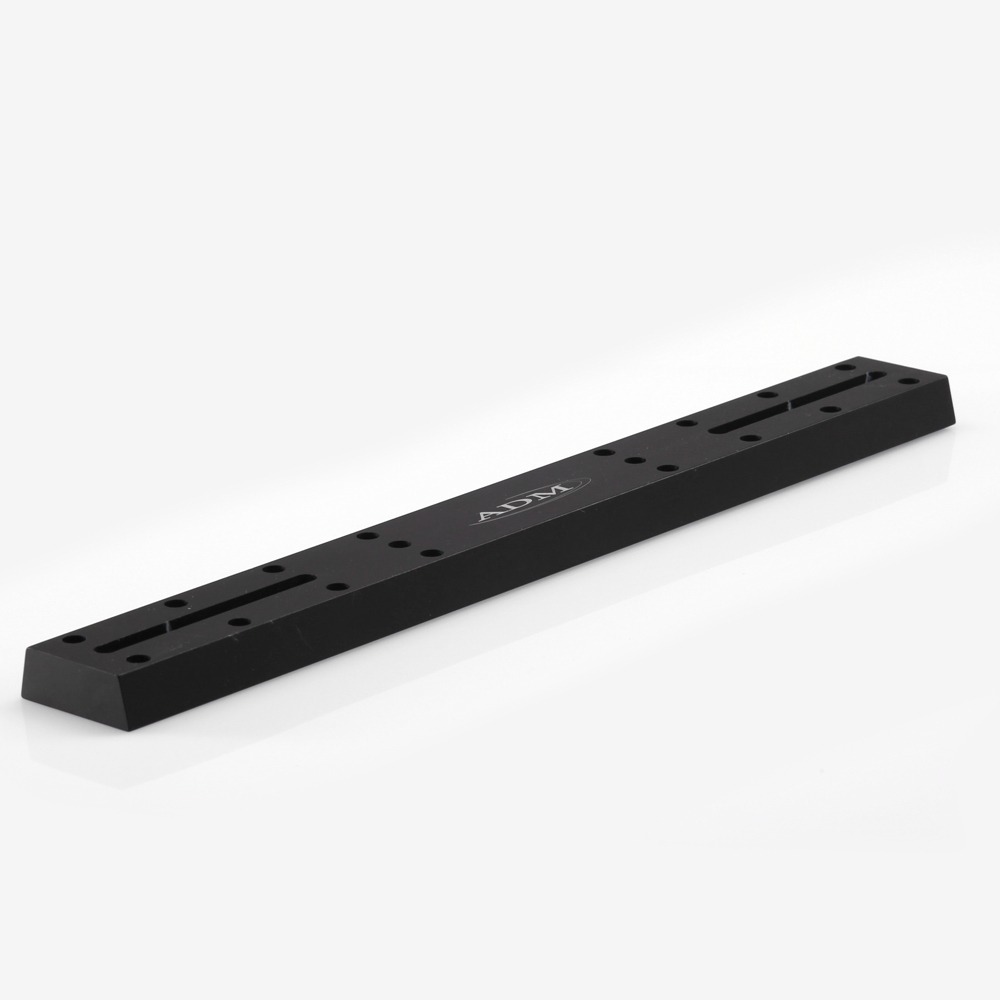
ADM zwaluwstaart in met een lengte van 35 cm
ADM VDUP14 Vixen zwaluwstaart verbinding zijn universele zwaluwstaarten in Vixen stijl afmeting. Deze zwaluwstaarten passen op diverse verschillende merken monteringen, zoals die van Celestron, Meade, Orion, iOptron, SkyWatcher, TeleVue, Vixen.
Deze zwaluwstaarten worden in 5 verschillende lengtes geleverd, de lengtes zijn dus variërend van 7.5 cm tot 35 cm. In alle maten zijn ze voorzien van een sleuf, in de drie langste maten zitten er ook gaten in. Deze gaten zitten op een hart afstand van 2.5 cm van elkaar in de breedte.
Prijzen veranderen in de winkelwagen. We zijn bezig om te zorgen dat de prijs meteen verandert bij het selecteren van de lengte van de VDUP.
Kenmerken van de ADM VDUP14 Vixen Zwaluwstaart zijn:
- Breedte van 4.3 cm
- Hoogte van 1.56 cm
- Lengte van 35 cm
Plaats je bestelling online of bezoek de showroom in Amstelveen
Heb je gevonden wat je zoekt en wil je bijvoorbeeld de ADM zwaluwstaart bestellen? Dan doe je dit heel eenvoudig online. Bekijk je deze producten liever in het echt voordat je ze koopt? Ook dat is bij ons mogelijk. Je bent van harte welkom in onze showroom in Amstelveen van maandag tot vrijdag tussen 10.00 en 17.00 uur. Op zaterdag is de showroom ook geopend, maar dan van 10.00 tot 16.30 uur. Voor meer informatie en advies kun je ook telefonisch contact met ons opnemen via 020-6412083. We helpen je graag
ADM VDUP11 Vixen zwaluwstaart verbinding
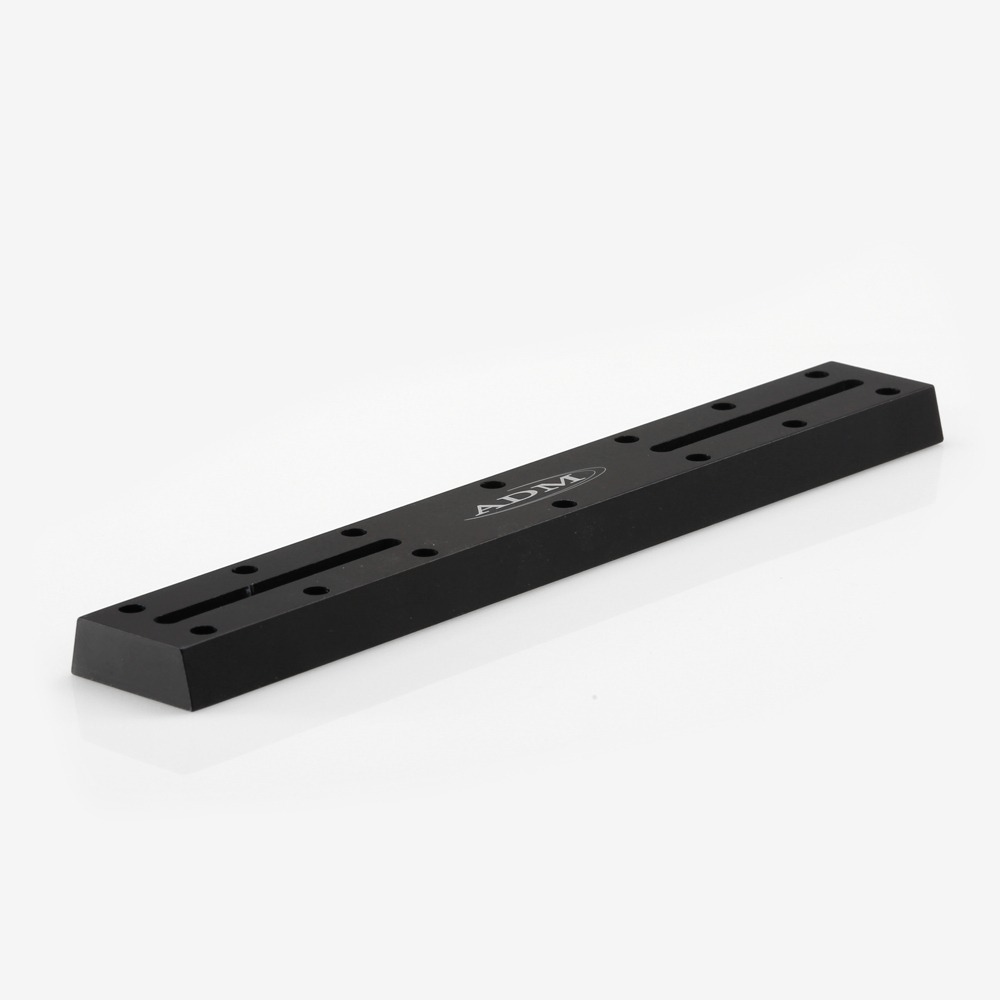
ADM zwaluwstaart in met een lengte van 27.5 cm
ADM VDUP11 Vixen zwaluwstaart verbinding zijn universele zwaluwstaarten in Vixen style afmeting. Deze zwaluwstaarten passen op diverse verschillende merken monteringen, zoals die van Celestron, Meade, Orion, iOptron, SkyWatcher, TeleVue, Vixen.
Deze zwaluwstaarten worden in 5 verschillende lengtes geleverd, de lengtes zijn dus variërend van 7.5 cm tot 35 cm. In alle maten zijn ze voorzien van een sleuf, in de drie langste maten zitten er ook gaten in. Deze gaten zitten op een hart afstand van 2.5 cm van elkaar in de breedte.
Prijzen veranderen in de winkelwagen. We zijn bezig om te zorgen dat de prijs meteen verandert bij het selecteren van de lengte van de VDUP.
Kenmerken van de ADM VDUP11 Vixen Zwaluwstaart zijn:
- Breedte van 4.3 cm
- Hoogte van 1.56 cm
- Lengte van 27.5 cm
Plaats je bestelling online of bezoek de showroom in Amstelveen
Heb je gevonden wat je zoekt en wil je bijvoorbeeld de ADM zwaluwstaart bestellen? Dan doe je dit heel eenvoudig online. Bekijk je deze producten liever in het echt voordat je ze koopt? Ook dat is bij ons mogelijk. Je bent van harte welkom in onze showroom in Amstelveen van maandag tot vrijdag tussen 10.00 en 17.00 uur. Op zaterdag is de showroom ook geopend, maar dan van 10.00 tot 16.30 uur. Voor meer informatie en advies kun je ook telefonisch contact met ons opnemen via 020-6412083. We helpen je graag.
ADM VDUP7 Vixen zwaluwstaart verbinding
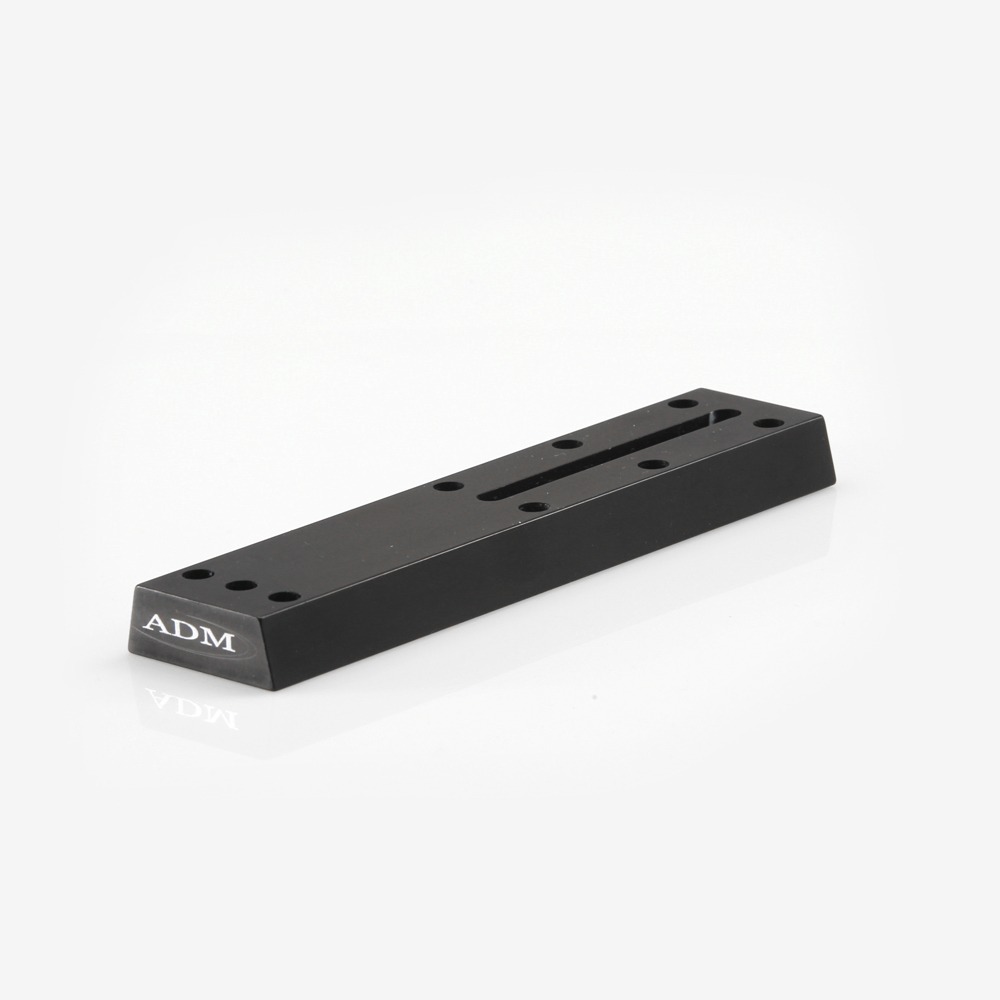
ADM VDUP7 Vixen Zwaluwstaart
VUDP zwaluwstaarten van ADM accessoires zijn universele zwaluwstaarten in Vixen style afmeting. Deze zwaluwstaarten passen op diverse verschillende merken monteringen, zoals die van Celestron, Meade, Orion, iOptron, SkyWatcher, TeleVue, Vixen.
Deze zwaluwstaarten worden in 5 verschillende lengtes geleverd, de lengtes zijn dus variërend van 7.5 cm tot 35 cm. In alle maten zijn ze voorzien van een sleuf, in de drie langste maten zitten er ook gaten in. Deze gaten zitten op een hart afstand van 2.5 cm van elkaar in de breedte.
Prijzen veranderen in de winkelwagen. We zijn bezig om te zorgen dat de prijs meteen verandert bij het selecteren van de lengte van de VDUP.
Kenmerken van de ADM VDUP7 Vixen Zwaluwstaart zijn:
- Breedte van 4.3 cm
- Hoogte van 1.56 cm
- Lengte van 17.5 cm
ZWO ASIAIR Plus WiFi control
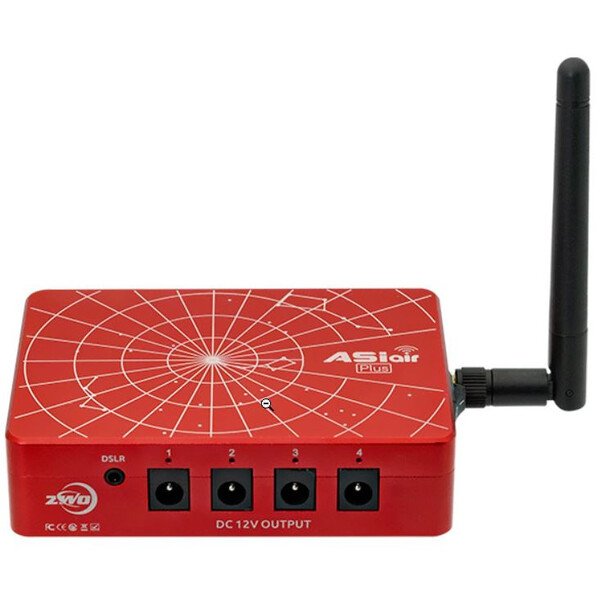
ZWO ASIAIR Plus WiFi makes astrophotography fun and easier
With the ZWO ASIAIR Plus WiFi module you can easily start with astrophotography. Whether it’s moon and planet or deep sky photos, the ASIAIR Plus makes it an easier task. This device also helps you with auto-guiding and pole alignment. The ASIAIR plus is the third generation and the most advanced version with 32 GB eMMC memory.
The ASIAIR PLUS is an intelligent WiFi controller for all astrophotography applications. It replaces a laptop or even an expensive stand-alone autoguider. The various cables that run here and there near the telescope are also a thing of the past, so there is less chance of cables getting caught. You only need your smartphone or tablet, which you connect to the ASIAIR Plus via the ZWO app.
The application possibilities are great
- Control of all ZWO ASI USB 3.0 cameras (cooled cameras require an extra power supply, this can be done via ASIAIR Plus)
- Autoguiding in combination with a ZWO MINI camera, such as the ZWO ASI120MM Mini or the ZWO ASI290MM Mini
- Controlling different mounts, for example iOptron or Celestron
- Connecting a DSLR camera.
- Autofocus with the ZWO EAF motorized focuser
- Debayer function for ZWO color cameras
- Live-Stacking
- Pole alignment
- Moon and planet photography
- And more…
Faster than its predecessor
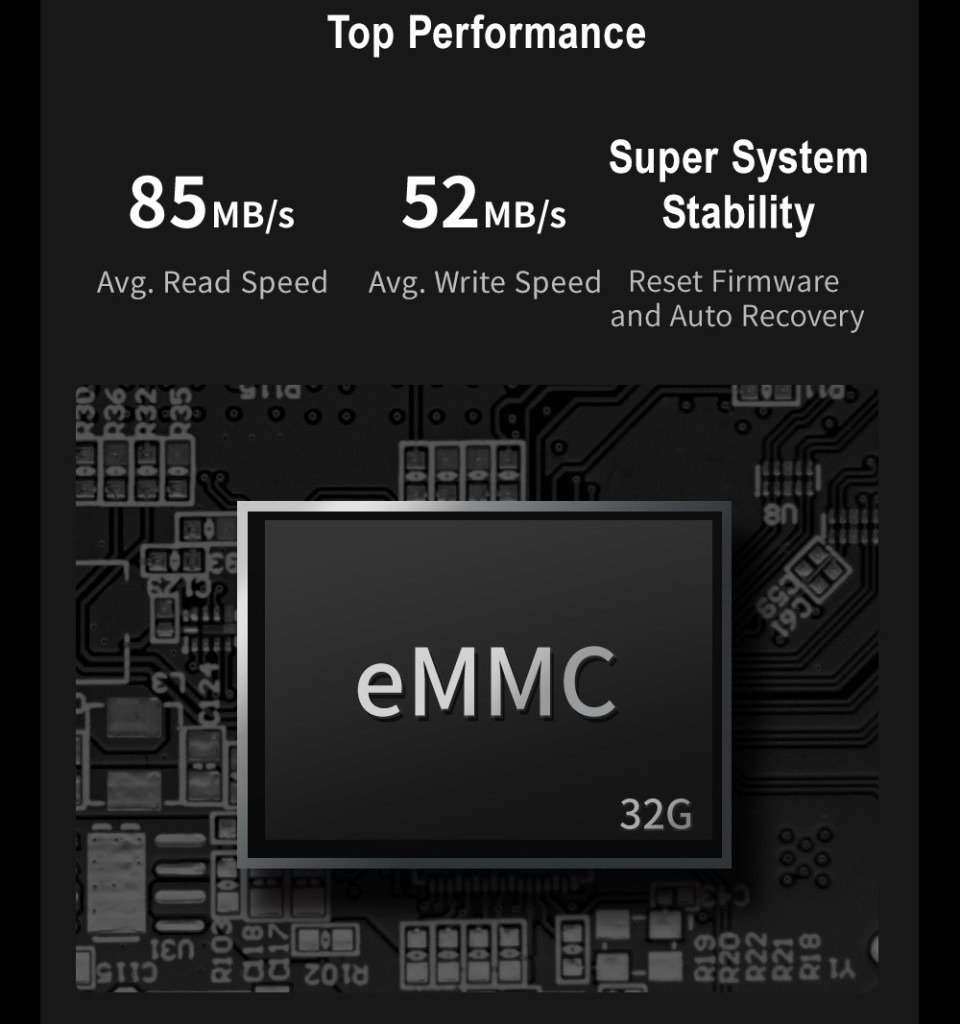
What’s new with the ASIAIR Plus?
- USB type C port
- WiFi antenna for longer range
- 32GB eMMC memory. (space available 20GB)
- Thinner and lighter in weight
- DC 12V output indicator lights
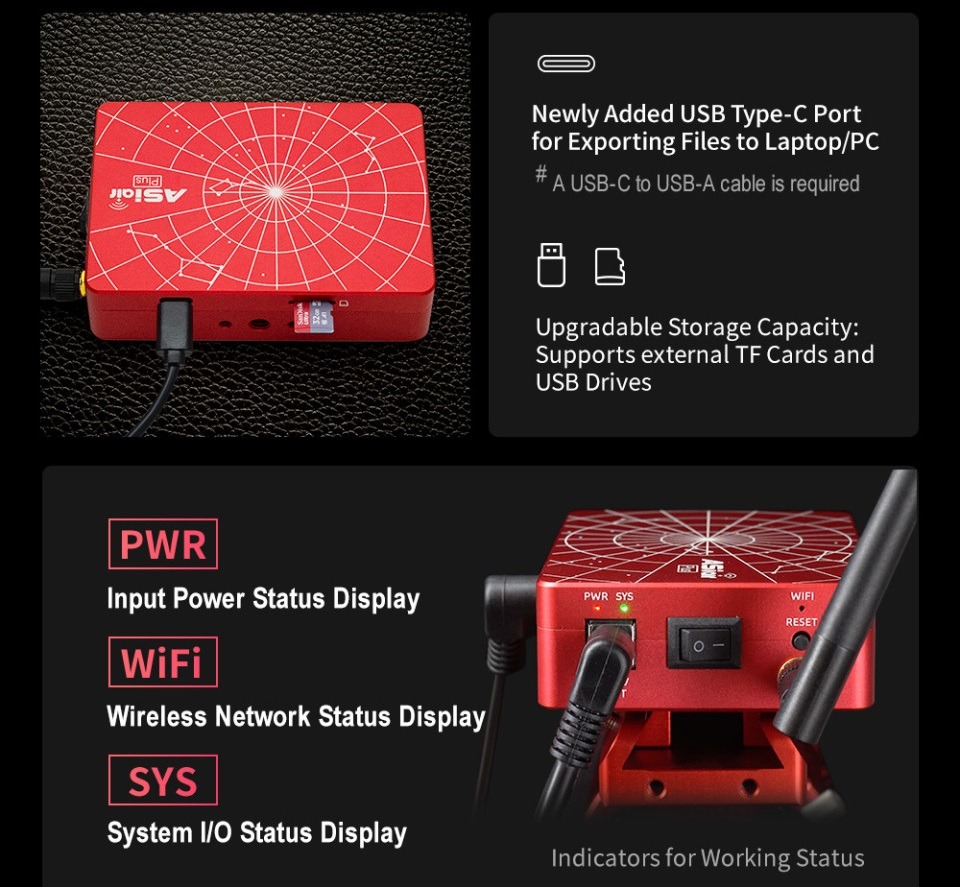
All in all, significant improvements that ZWO has implemented with the ASIAIR Plus. The housing is made of aluminum and manufactured with a CNC machine. The ASIAIR Plus is 24% thinner and 13% lighter than its predecessor, the ASIAIR Pro.
Delivery of the ZWO ASIAIR Plus WiFi control includes:
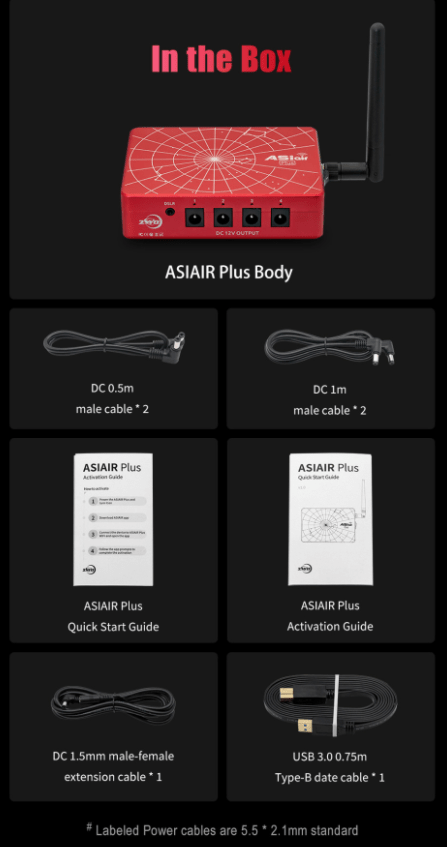
Note: a separate power supply for the ASIAIR Plus is not included. The ASAIR is supplied with 12v power by means of a 2.1mm plug, you can order this for example.
Note: SkyWatcher mounts may require an EQDir cable. The connection with the USB-RS232 cable does not always work!
Frequently Asked Questions
1. What is the ASAIR Plus?
ASIAIR is an integrated solution developed by ZWO for astrophotography, the world’s first large-scale commercial product. ASIAIR Plus is a new improved third edition wireless intelligent controller.
2. What can ASIAIR Plus do?
ASIAIR Plus connects the necessary equipment for astrophotography through the device. You install the ASIAIR app on a mobile phone or tablet for wireless control and complete various photographic creation processes, such as:
- image plate solving
- scope focus
- polar align
- auto guiding
- auto-run (unmanned imaging)
- plan (multi-target/mosaic imaging)
- live stacking
- video (planterary imaging)
- etc.
3. What devices can ASIAIR control?
All necessary equipment for performing astrophotography is supported.
- Supports all ASI USB 3.0 and Mini series professional astronomical cameras
- A selection of nearly 100 Canon and Nikon SLR and mirrorless cameras
- Support for the ZWO EAF (all variants) and the ZWO EFW (all variants)
- Support more than 400 common equatorial or partial alt-azimuth mounts on the market
The ASIAIR Pro does not support the ASI 120 MM/MC USB 2.0!
Text from the ZWO site: supported cameras are ASI USB3.0 cameras, ASI cooled cameras, ASI mini cameras and DSLR cameras (It can not support ASI120MM/MC camera).
4. Where can I download the ASIAIR app? How to update the app in the future?
You can search for the keyword ASIAIR in all major app stores to download, install and update. After connecting to the ASIAIR WiFi, you can upgrade the firmware with a new app version.
5. What are the ASIAIR Plus power requirements?
The recommended power supply is 11V-15V @ 2A-5A. If it is below 9V or above 15V, ASIAIR Plus cannot be switched on for safety reasons. Please note that a separate power supply is not included.
6. Are there any restrictions on external storage? What is the Type-C USB port?
Support TF card, support external USB storage, such as USB drive, SSD, etc. As a storage capacity, it is recommended to have 512 GB and a maximum of 1 TB. Currently, it supports three file system formats: NTFS, FAT32, and exFAT. The Type-C port is only used to connect ASIAIR Plus to a computer and export files from internal storage and TF card. Data cable with Type-C ports on both ends is not supported.
Benefit from the top quality of this control
The high quality of this control from ZWO will not disappoint you. Order your ZWO ASIAIR Plus easily online at Ganymedes and get started with this fine device. You are also very welcome in our showroom in Amstelveen, where you can view and possibly test our collection. Also discover products from other brands in our range, such as PrimaLuceLab and Pegasus Astro. Do you have questions? We are happy to help you via 020-6412083.
ADM VDUP4 Vixen zwaluwstaart verbinding
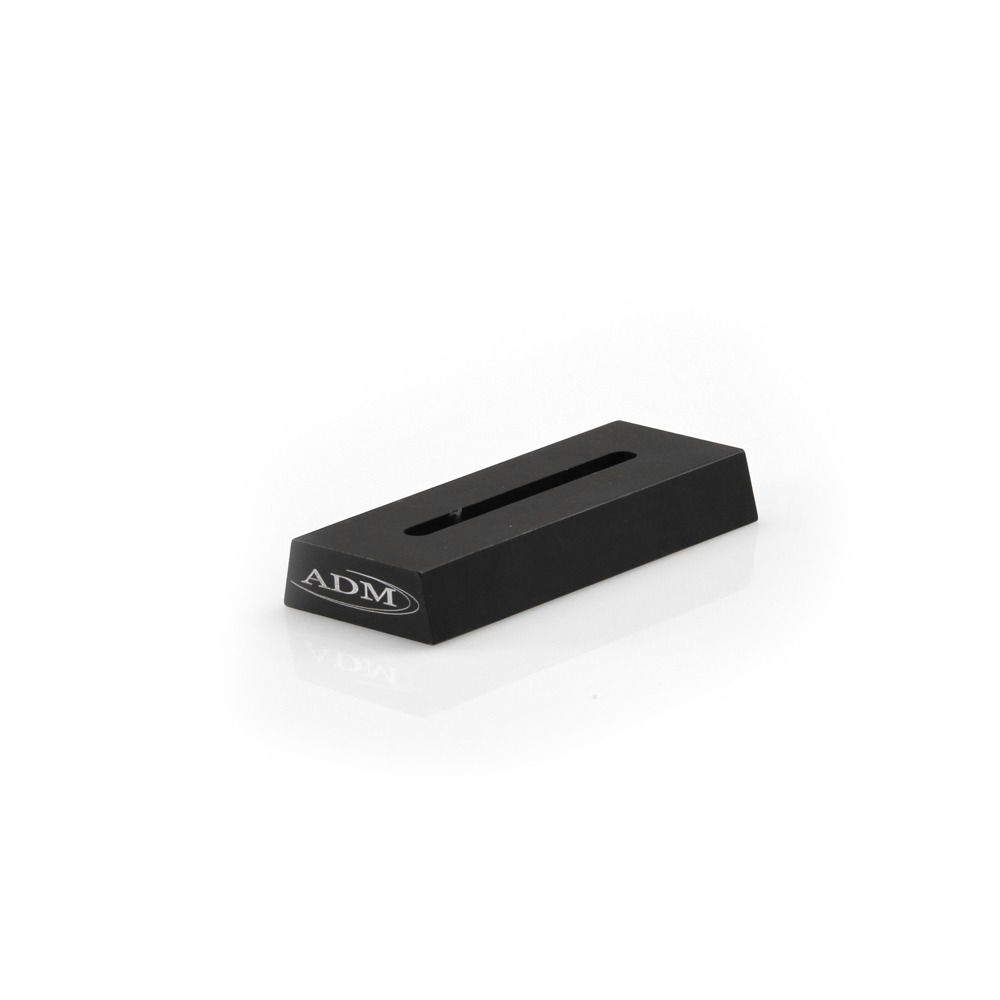
ADM zwaluwstaart in met een lengte van 10 cm
ADM VDUP4 Vixen zwaluwstaart verbinding zijn universele zwaluwstaarten in Vixen style afmeting. Deze zwaluwstaarten passen op diverse verschillende merken monteringen, zoals die van Celestron, Meade, Orion, iOptron, SkyWatcher, TeleVue, Vixen.
Deze zwaluwstaarten worden in 5 verschillende lengtes geleverd, de lengtes zijn dus variërend van 7.5 cm tot 35 cm. In alle maten zijn ze voorzien van een sleuf, in de drie langste maten zitten er ook gaten in. Deze gaten zitten op een hart afstand van 2.5 cm van elkaar in de breedte.
Prijzen veranderen in de winkelwagen. We zijn bezig om te zorgen dat de prijs meteen verandert bij het selecteren van de lengte van de VDUP.
Kenmerken van de ADM VDUP4 Vixen Zwaluwstaart zijn:
- Breedte van 4.3 cm
- Hoogte van 1.56 cm
- Lengte van 10 cm
Plaats je bestelling online of bezoek de showroom in Amstelveen
Heb je gevonden wat je zoekt en wil je bijvoorbeeld de ADM zwaluwstaart bestellen? Dan doe je dit heel eenvoudig online. Bekijk je deze producten liever in het echt voordat je ze koopt? Ook dat is bij ons mogelijk. Je bent van harte welkom in onze showroom in Amstelveen van maandag tot vrijdag tussen 10.00 en 17.00 uur. Op zaterdag is de showroom ook geopend, maar dan van 10.00 tot 16.30 uur. Voor meer informatie en advies kun je ook telefonisch contact met ons opnemen via 020-6412083. We helpen je graag
Pegasus Astro Power Supply 2.5 mm connector
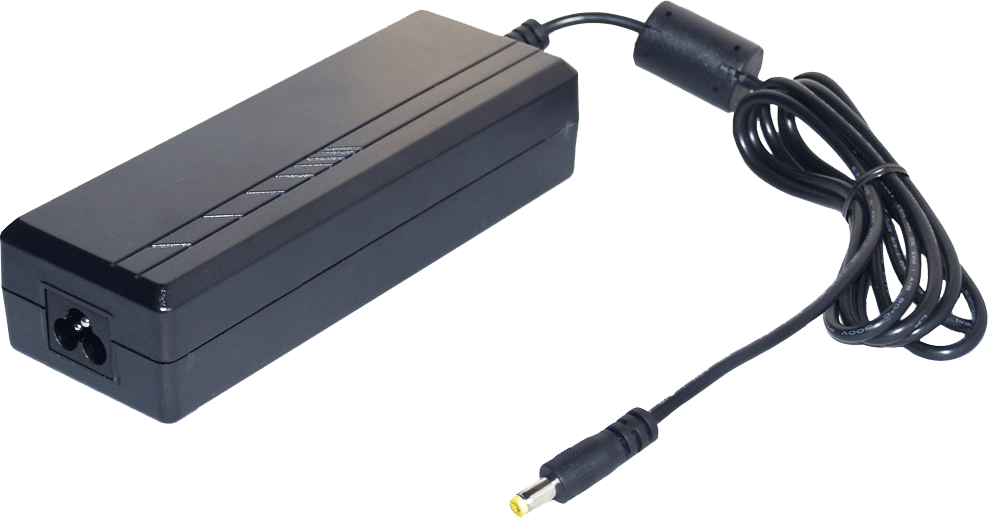
220 volt naar 12 volt voeding met 10 ampère uitgifte. Connector is 5.5×2.5
Pegasus Astro Power Supply 2.5 mm connector voor het voeden van diverse randapparatuur zoals pocket powerbox bijvoorbeeld. Ioptron montering vanaf CEM40 werken ook met 5.5×2.5mm connector dus ook hiervoor is deze voeding geschikt.
Deze Pegasus Astro voeding is voorzien van verschillende beveiligingsfuncties, te weten:
- Overstroom / korte bescherming: de voeding zal elke uitvoer naar aarde beschermen en automatisch herstellen wanneer abnormale circuitfouten worden verwijderd. Een uitgangskortsluiting wordt gedefinieerd als een uitgangsimpedantie van minder dan 0,1 ohm.
- Overspanning: de voeding wordt automatisch hersteld wanneer fouten worden verwijderd
- Ingangsbeveiliging: F1:6.3A 250V zekering de voeding moet worden beschermd tegen spanningspieken en andere abnormale omstandigheden
- Beveiliging tegen onbelaste voeding: de voeding wordt geleverd zonder belasting om schade aan de voeding en het systeem te voorkomen.
- Beschermingsklasse: I
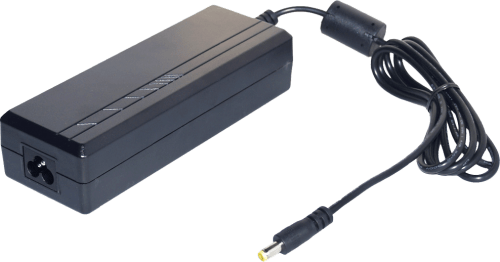
Levering van de Pegasus Astro Power Supply 2.5 mm connector omvat:
- Voeding 220v / 12v / 10A met 5.5×2.5 mm conector
- Europees voeding snoer
Plaats je bestelling online of kom langs in de winkel
Heb je gevonden wat je zoekt en wil je bijvoorbeeld de voeding bestellen? Of ander Pegasus Astro producten? Dan doe je dit heel eenvoudig online. Bekijk je deze producten liever in het echt voordat je ze koopt? Ook dat is bij ons mogelijk. Je bent van harte welkom in onze showroom in Amstelveen van maandag tot vrijdag tussen 10.00 en 17.00 uur. Op zaterdag is de showroom ook geopend, maar dan van 10.00 tot 16.30 uur. Voor meer informatie en advies kun je ook telefonisch contact met ons opnemen via 020-6412083. We helpen je graag
PrimaLuceLab Eagle4 S advanced control unit
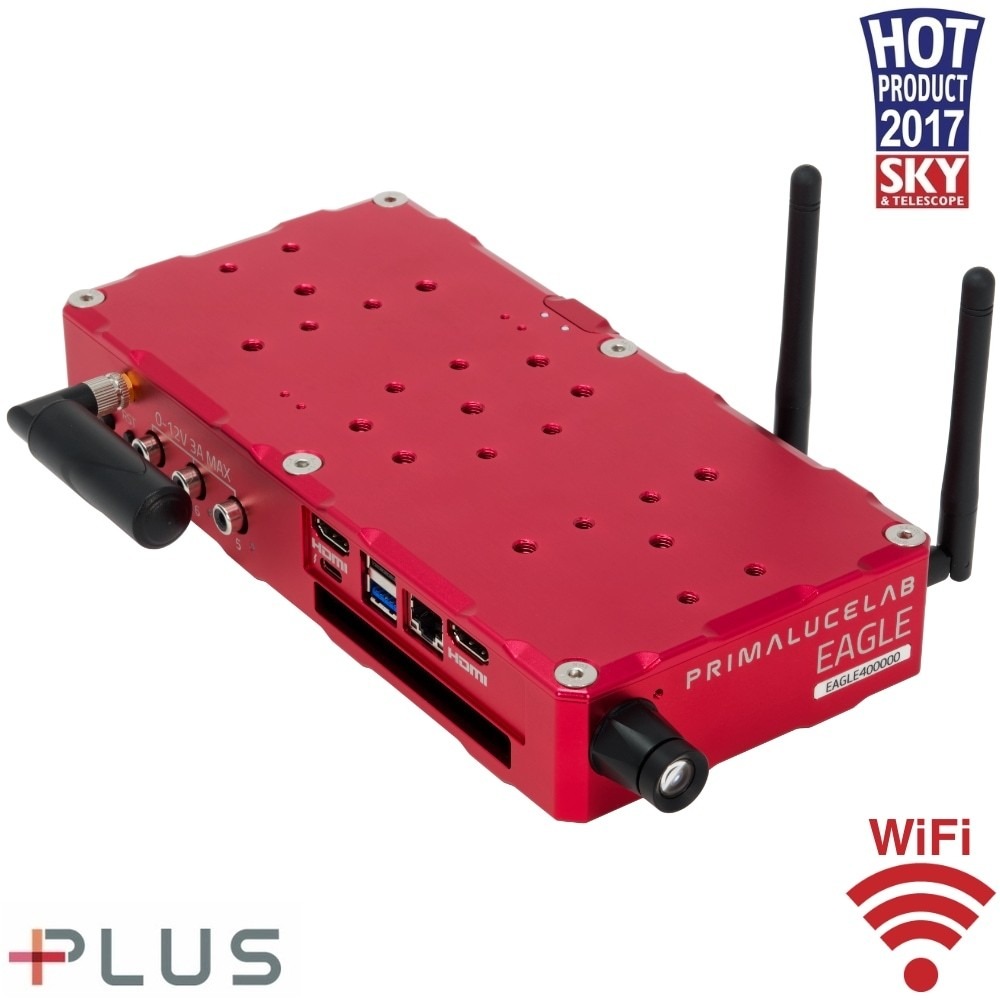
Description of the PrimaLuceLab EAGLE4 S advanced control unit
EAGLE4 S is the more powerful version of the EAGLE4. With its Dual Core i3 processor (with Turbo Mode up to 3.9 GHz), 8 GB of fast memory, larger SSD (240 GB) and added Thunderbolt 3 port with USB-C connector (which enables even more high-speed connectivity, up to 40 Gbps, to devices such as fast storage if you need extra space), EAGLE4 S offers even more power for complex applications! All in a lightweight, compact all-in-one design that can be installed on your telescope and comes with all the advanced features of EAGLE4.
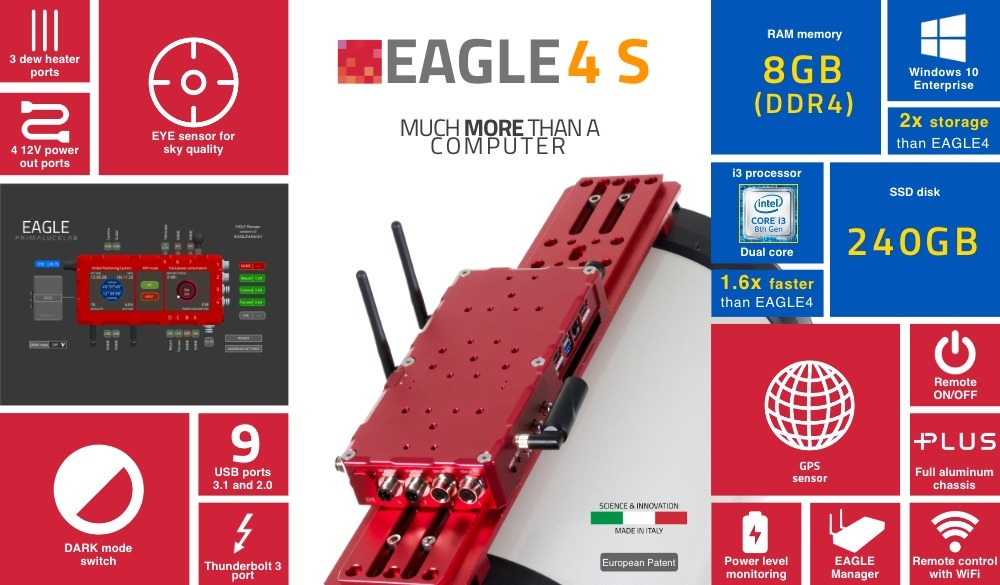
If you want an EAGLE device with more power and storage space, but at the same time take advantage of a compact system with low power consumption, the EAGLE4 S is perfect. This device performs exceptionally, with an average power consumption of only 1A. That means it can be charged with a small, ‘normal’ battery, but delivers more than 1.6 times the performance of a standard EAGLE. In short: as a specialist, we are therefore convinced that this PrimaLuceLab model is an indispensable device in our collection of astronomical products!
Intel’s 8th Gen i3 processor with a TDP of only 15 W and 4 MB cache offers desktop-class performance with low power consumption. PrimaLuceLab’s EAGLE4 S offers three USB 3.1 type A ports with data transfer speeds of up to 10 Gbps; one USB Type-C/Thunderbolt 3 port with data transfer rates of up to 40 Gbps, as well as five USB 2.0 ports, two HDMI 2.0a ports, a Gigabit LAN port, and Wireless 802.11ac.
Thunderbolt
PrimaLuceLab’s EAGLE4 S also adds an incredibly fast and powerful Thunderbolt 3 port with USB-C type connector, enabling connections up to 40 Gbps with more connectivity options. Compared to a standard USB port, USB-C/Thunderbolt adds many extra features:
- Speed: while USB 3.0 is up to 5 Gbps, the Thunderbolt 3 port offers connectivity speeds of up to 40 Gbps.
- Power: the Thunderbolt 3 port is capable of delivering up to 15W.
- Connectivity: you can connect many devices to it, such as external drives, displays, multi-port docking stations, and audio devices. You can connect up to 6 devices in series via a single compact port. Since the cable has a USB-C connector, it’s reversible so you can’t plug it in wrong. If you have a standard USB-C device, you can connect it to the Thunderbolt 3 port (in which case the maximum speed is 10 Gbps).
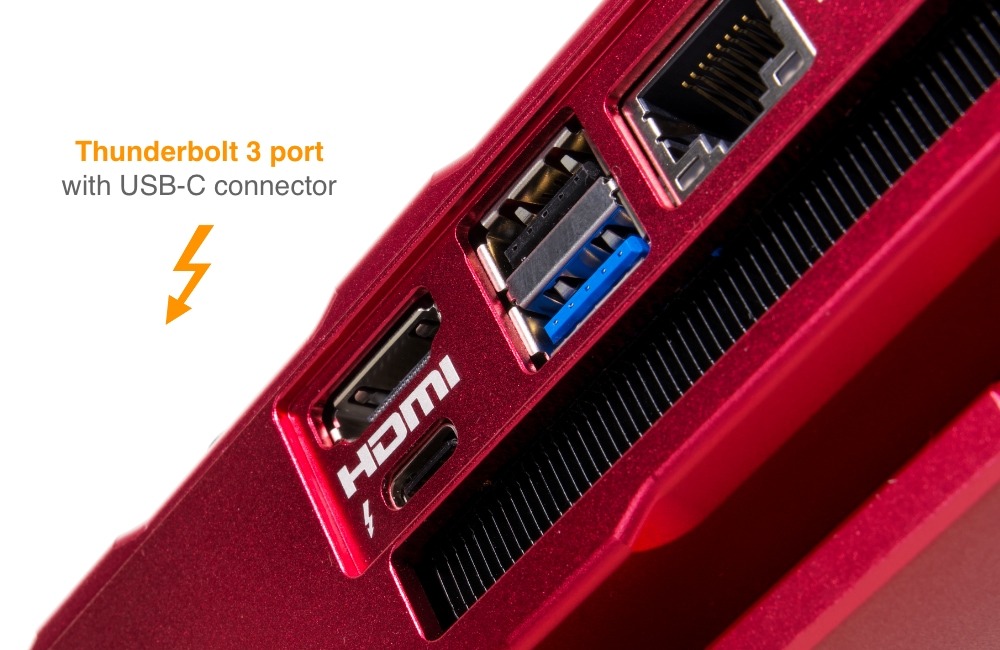
Performance
PrimaLuceLab’s EAGLE4 S not only offers exclusive features for advanced astrophotography, but also has all the power of a real computer. This way you will be able to use all astrophotography software. As you can see in the image below, PrimaLuceLab’s EAGLE4 offers 32% more performance than a regular Mini PC with Intel Celeron N3160 processor, 4GB RAM and SSD drive. The EAGLE4 S brings this difference to 109%, while the EAGLE4 PRO even delivers an improvement of +153%!
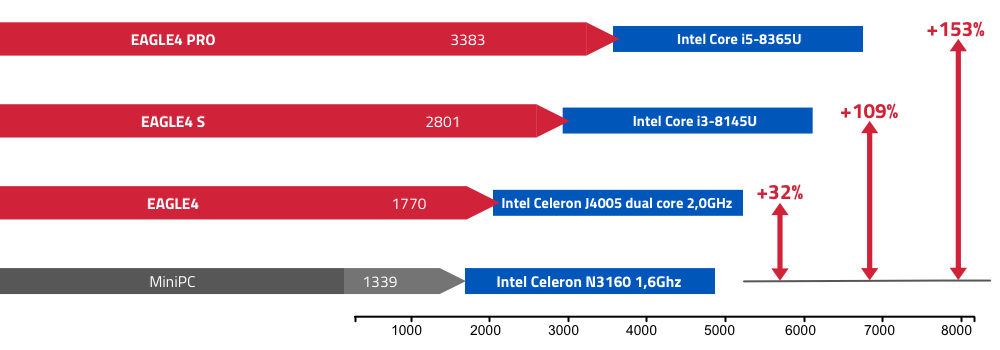
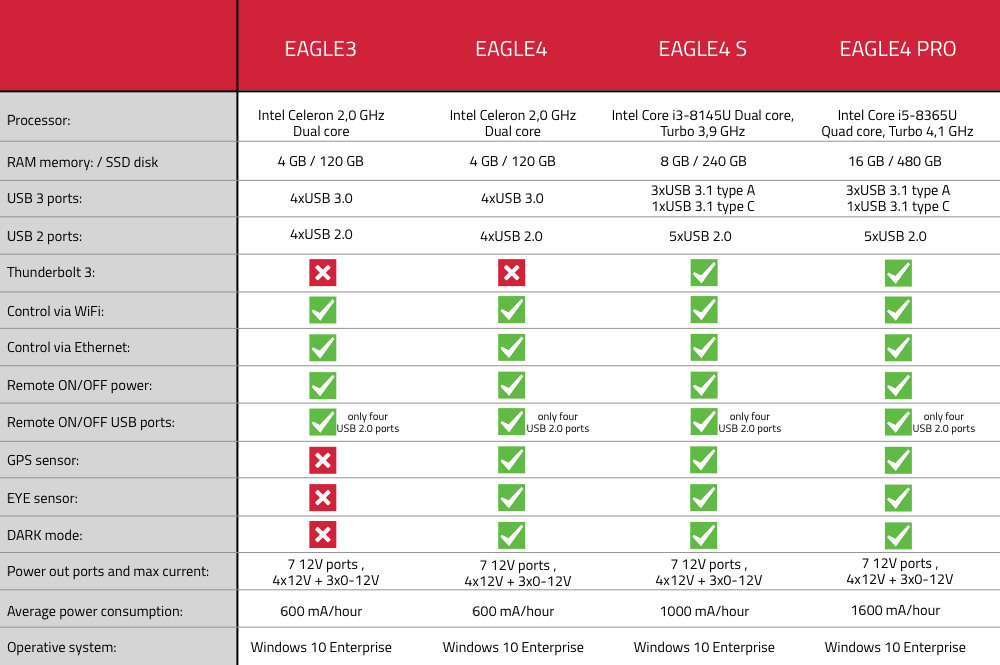
Delivery of the PrimaLuceLab Eagle4 S advanced control unit includes:
- EAGLE device
- 2 WiFi antennas
- GPS antenna
- 12V power cable with cigarette plug for EAGLE – 250cm
- n.4 M6x8 screws + n.4 M6x10 screws + n.4 M6x12 screws + n.4 n.4 M6x18 screws + n.4 M6x25 screws + n.4 M6x35 screws
- Quick guide
Request more information or order directly online
Thanks to PrimaLuceLab’s EAGLE4 S, your instrument has the high quality of an astrophotographic telescope, but the ease of use of a starter tracker. Lugging heavy computers is a thing of the past, as is blurred images because you accidentally touch the camera while shooting. Order this device easily online or in our showroom in Amstelveen. Would you like more information about this PrimaLuceLab product or other products, such as the iOptron SkyGuider or the Optolong filters? Call 020-6412083 and we will be happy to help you.
Ganymedes verloopkabel 5.5×2.1 naar 5.5×2.5
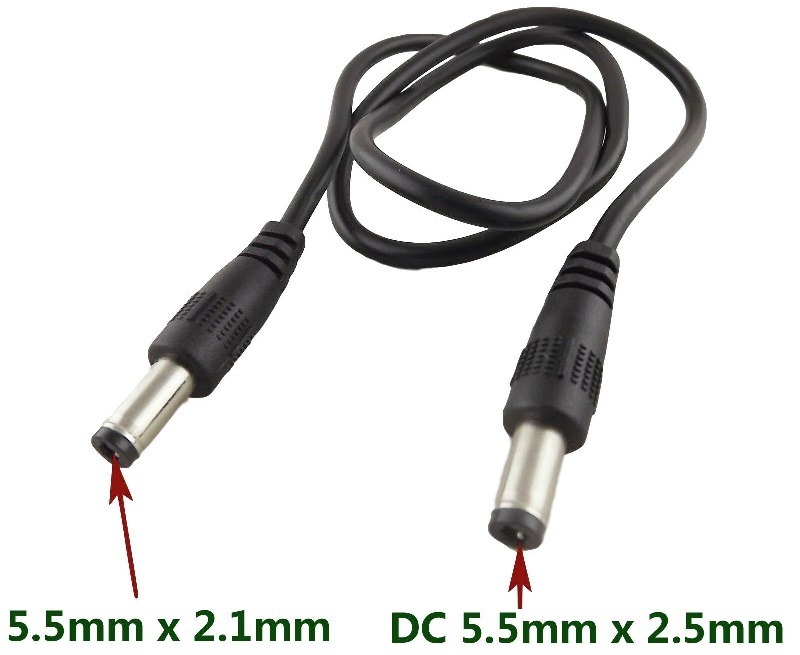
Ganymedes verloopkabel 5.5×2.1 naar 5.5×2.5
Met deze verloopkabel kan je makkelijk van 5.5×2.1 connector naar 5.5×2.5 connector gaan. Bijvoorbeeld iOptron montering met een 5.5×2.5 naar een voedingsuitgang van ZWO ASIAIR die een aansluiting heeft van 5.5×2.1.
Specificaties van het Ganymedes verloopkabel 5.5×2.1 naar 5.5×2.5 zijn:
- Lengte: 60 cm
- Connector: 5.5×2.1 male
- Connector: 5.5×2.5 male
ZWO ASIAIR Plus WiFi control 256GB

ZWO ASIAIR Plus WiFi makes astrophotography fun and easier
With the ZWO ASIAIR Plus WiFi module you can easily start with astrophotography. Whether it’s moon and planet or deep sky photos, the ASIAIR Plus makes it an easier task. This device also helps you with auto-guiding and pole alignment. The ASIAIR plus is the third generation and the most advanced version with 32 GB eMMC memory.
The ASIAIR PLUS is an intelligent WiFi controller for all astrophotography applications. It replaces a laptop or even an expensive stand-alone autoguider. The various cables that run here and there near the telescope are also a thing of the past, so there is less chance of cables getting caught. You only need your smartphone or tablet, which you connect to the ASIAIR Plus via the ZWO app.
The application possibilities are great
- Control of all ZWO ASI USB 3.0 cameras (cooled cameras require an extra power supply, this can be done via ASIAIR Plus)
- Autoguiding in combination with a ZWO MINI camera, such as the ZWO ASI120MM Mini or the ZWO ASI290MM Mini
- Controlling different mounts, for example iOptron or Celestron
- Connecting a DSLR camera.
- Autofocus with the ZWO EAF motorized focuser
- Debayer function for ZWO color cameras
- Live-Stacking
- Pole alignment
- Moon and planet photography
- And more…
Faster than its predecessor

What’s new with the ASIAIR Plus?
- USB type C port
- WiFi antenna for longer range
- 32GB eMMC memory. (space available 20GB)
- Thinner and lighter in weight
- DC 12V output indicator lights

All in all, significant improvements that ZWO has implemented with the ASIAIR Plus. The housing is made of aluminum and manufactured with a CNC machine. The ASIAIR Plus is 24% thinner and 13% lighter than its predecessor, the ASIAIR Pro.
Delivery of the ZWO ASIAIR Plus WiFi control includes:

Note: a separate power supply for the ASIAIR Plus is not included. The ASAIR is supplied with 12v power by means of a 2.1mm plug, you can order this for example.
Note: SkyWatcher mounts may require an EQDir cable. The connection with the USB-RS232 cable does not always work!
Frequently Asked Questions
1. What is the ASAIR Plus?
ASIAIR is an integrated solution developed by ZWO for astrophotography, the world’s first large-scale commercial product. ASIAIR Plus is a new improved third edition wireless intelligent controller.
2. What can ASIAIR Plus do?
ASIAIR Plus connects the necessary equipment for astrophotography through the device. You install the ASIAIR app on a mobile phone or tablet for wireless control and complete various photographic creation processes, such as:
- image plate solving
- scope focus
- polar align
- auto guiding
- auto-run (unmanned imaging)
- plan (multi-target/mosaic imaging)
- live stacking
- video (planterary imaging)
- etc.
3. What devices can ASIAIR control?
All necessary equipment for performing astrophotography is supported.
- Supports all ASI USB 3.0 and Mini series professional astronomical cameras
- A selection of nearly 100 Canon and Nikon SLR and mirrorless cameras
- Support for the ZWO EAF (all variants) and the ZWO EFW (all variants)
- Support more than 400 common equatorial or partial alt-azimuth mounts on the market
The ASIAIR Pro does not support the ASI 120 MM/MC USB 2.0!
Text from the ZWO site: supported cameras are ASI USB3.0 cameras, ASI cooled cameras, ASI mini cameras and DSLR cameras (It can not support ASI120MM/MC camera).
4. Where can I download the ASIAIR app? How to update the app in the future?
You can search for the keyword ASIAIR in all major app stores to download, install and update. After connecting to the ASIAIR WiFi, you can upgrade the firmware with a new app version.
5. What are the ASIAIR Plus power requirements?
The recommended power supply is 11V-15V @ 2A-5A. If it is below 9V or above 15V, ASIAIR Plus cannot be switched on for safety reasons. Please note that a separate power supply is not included.
6. Are there any restrictions on external storage? What is the Type-C USB port?
Support TF card, support external USB storage, such as USB drive, SSD, etc. As a storage capacity, it is recommended to have 512 GB and a maximum of 1 TB. Currently, it supports three file system formats: NTFS, FAT32, and exFAT. The Type-C port is only used to connect ASIAIR Plus to a computer and export files from internal storage and TF card. Data cable with Type-C ports on both ends is not supported.
Benefit from the top quality of this control
The high quality of this control from ZWO will not disappoint you. Order your ZWO ASIAIR Plus easily online at Ganymedes and get started with this fine device. You are also very welcome in our showroom in Amstelveen, where you can view and possibly test our collection. Also discover products from other brands in our range, such as PrimaLuceLab and Pegasus Astro. Do you have questions? We are happy to help you via 020-6412083.
